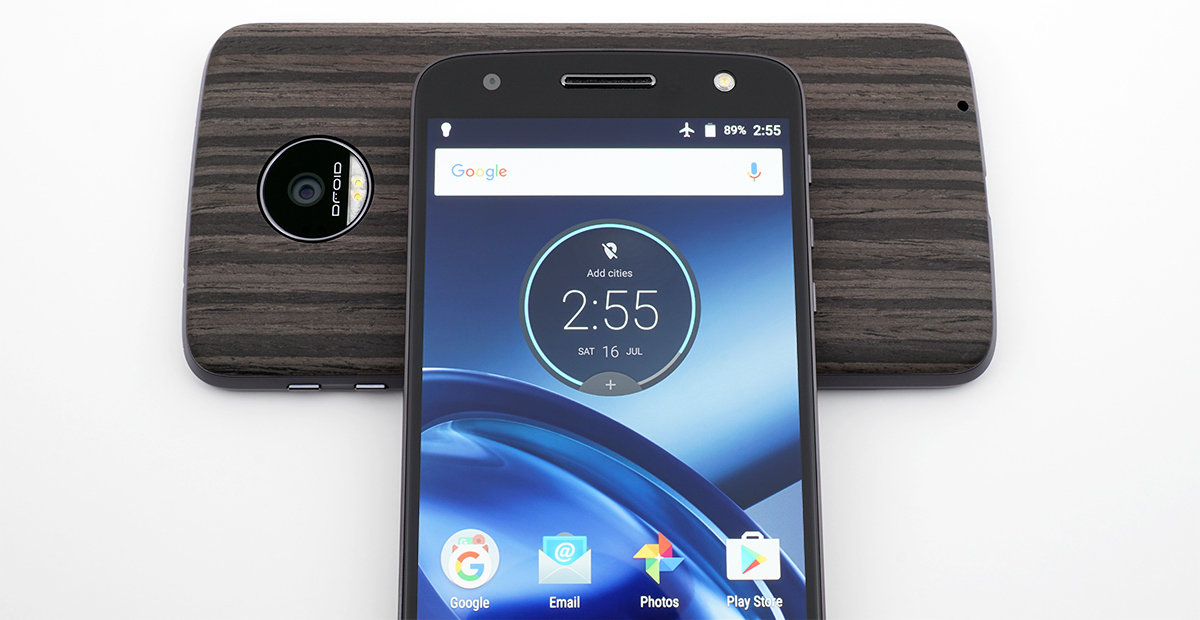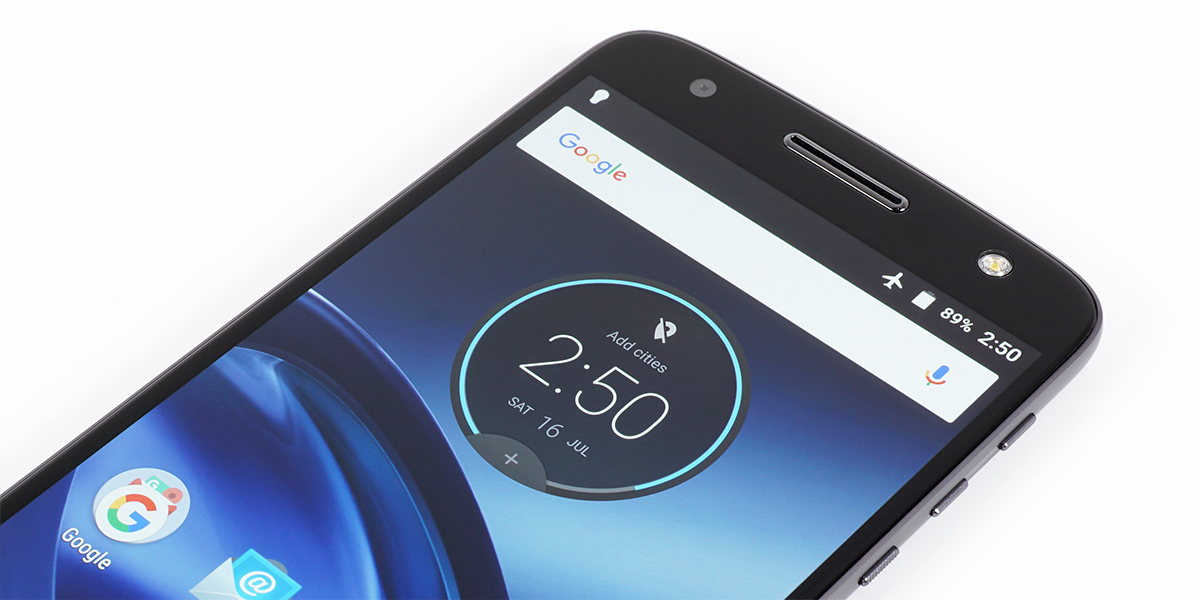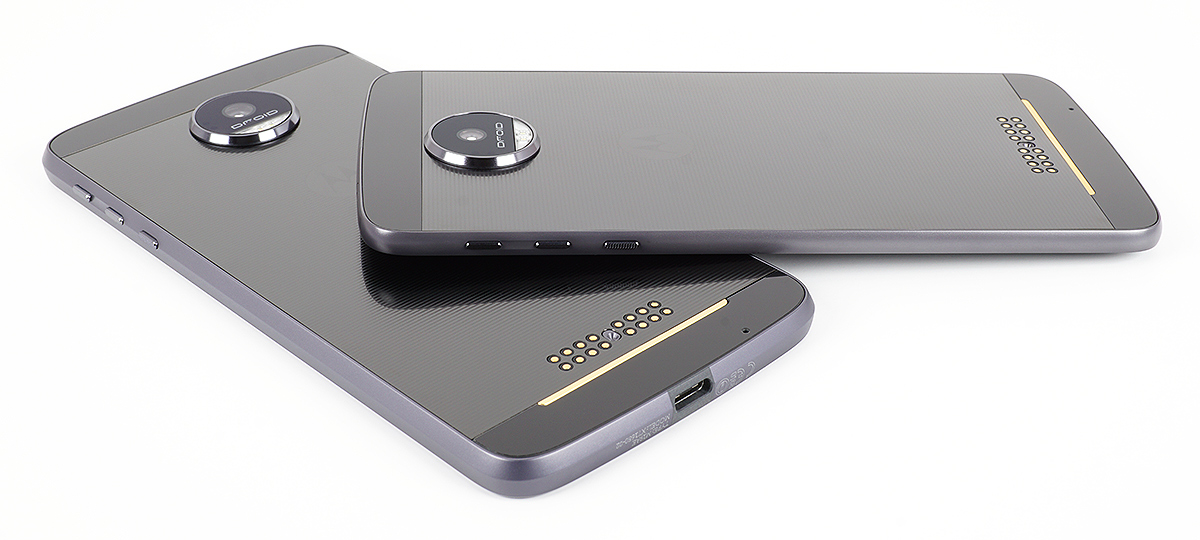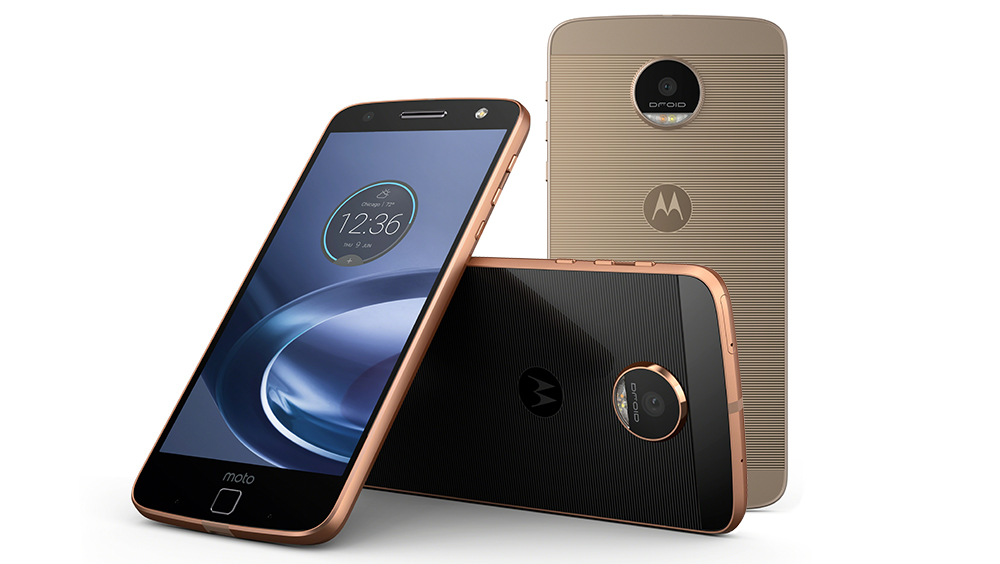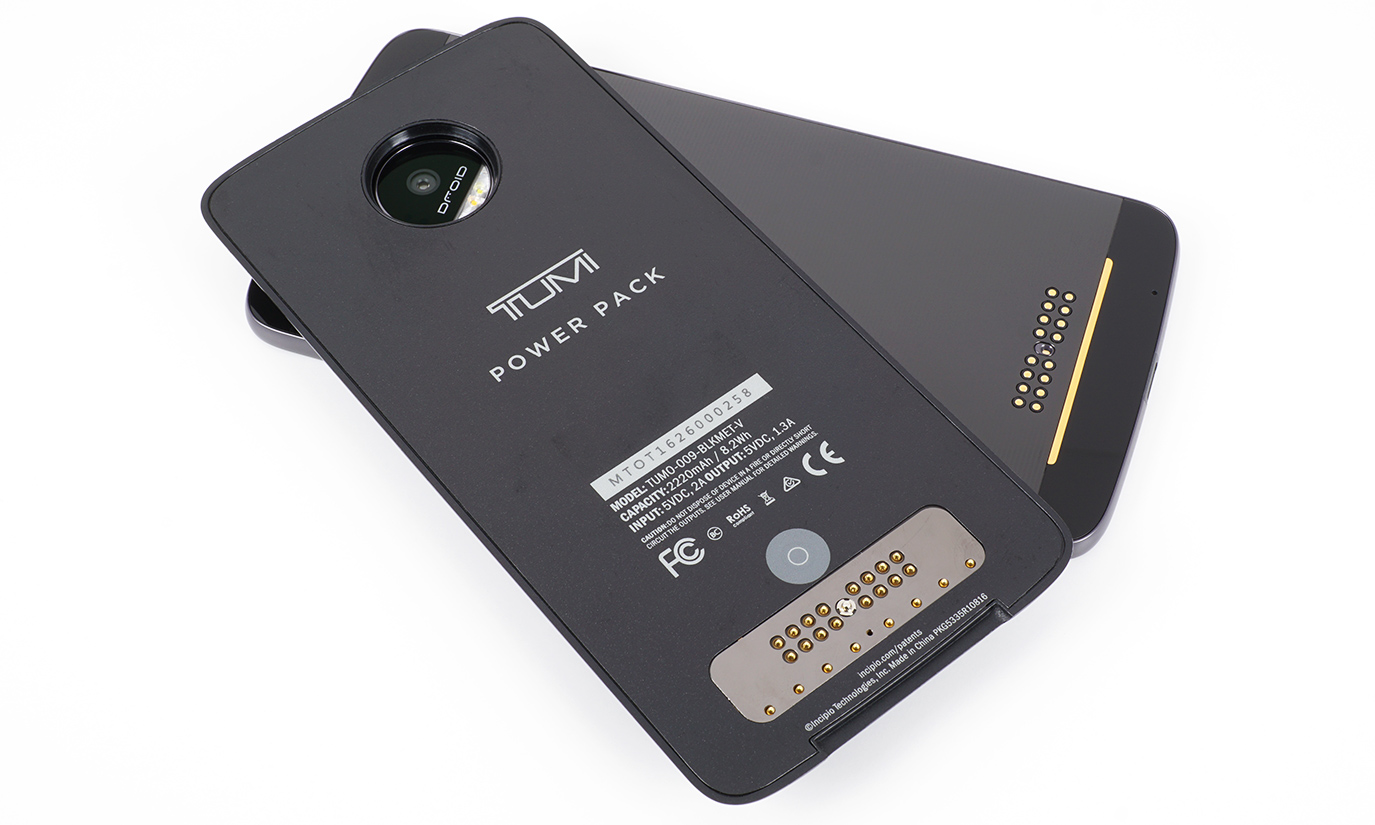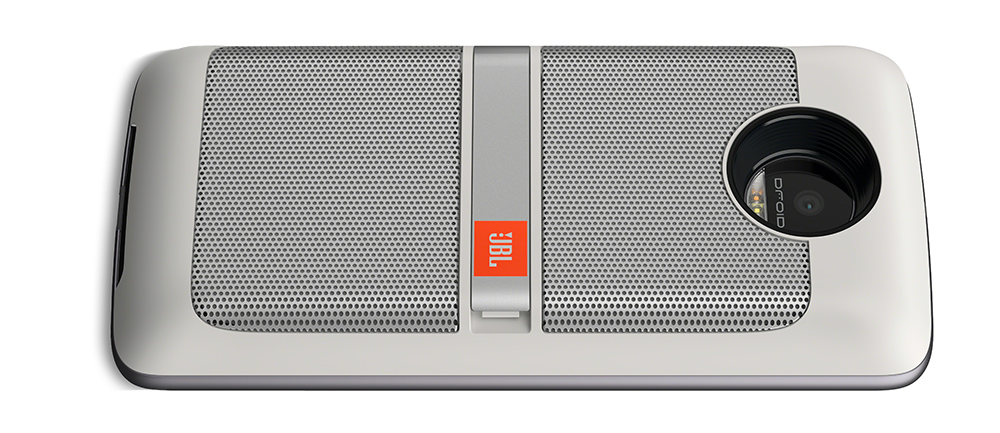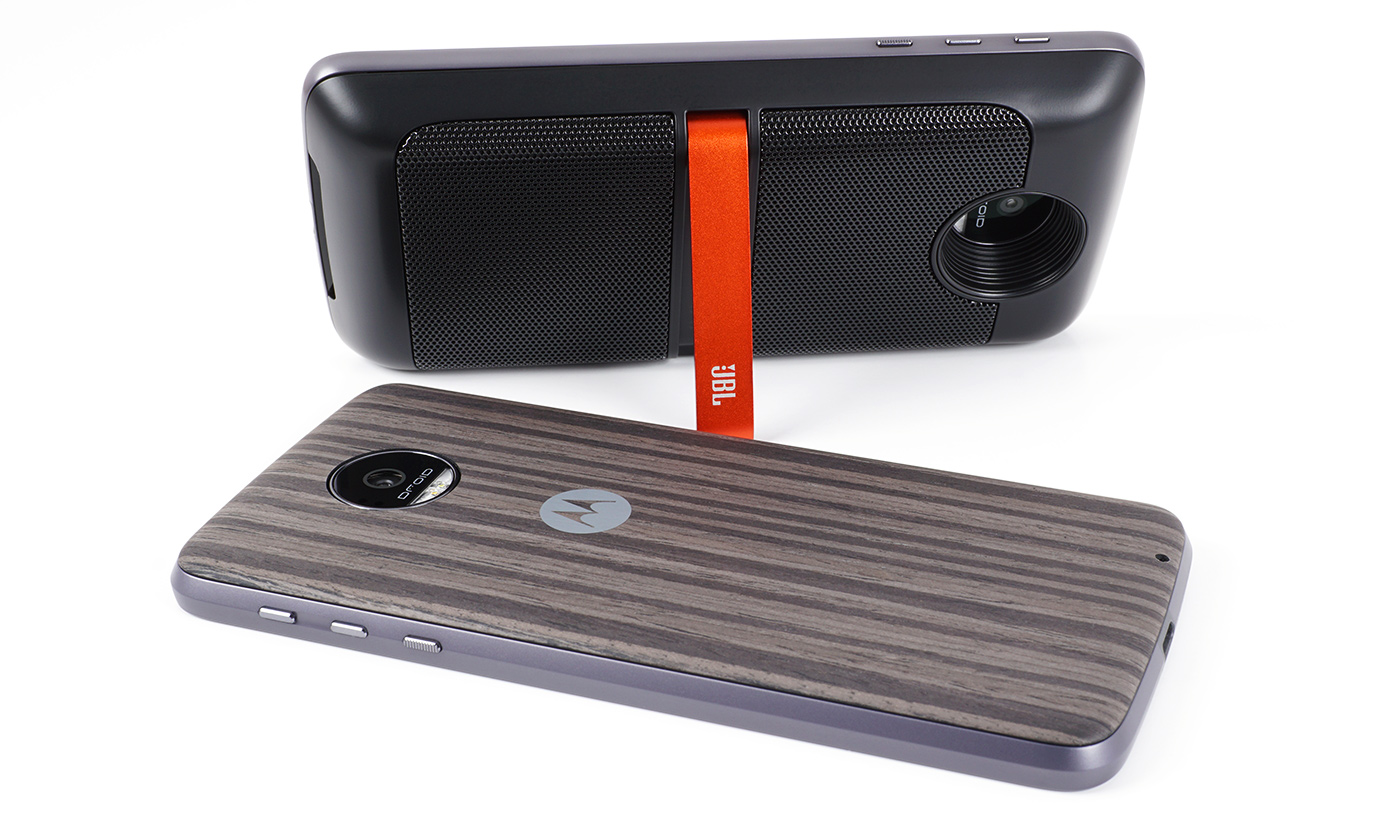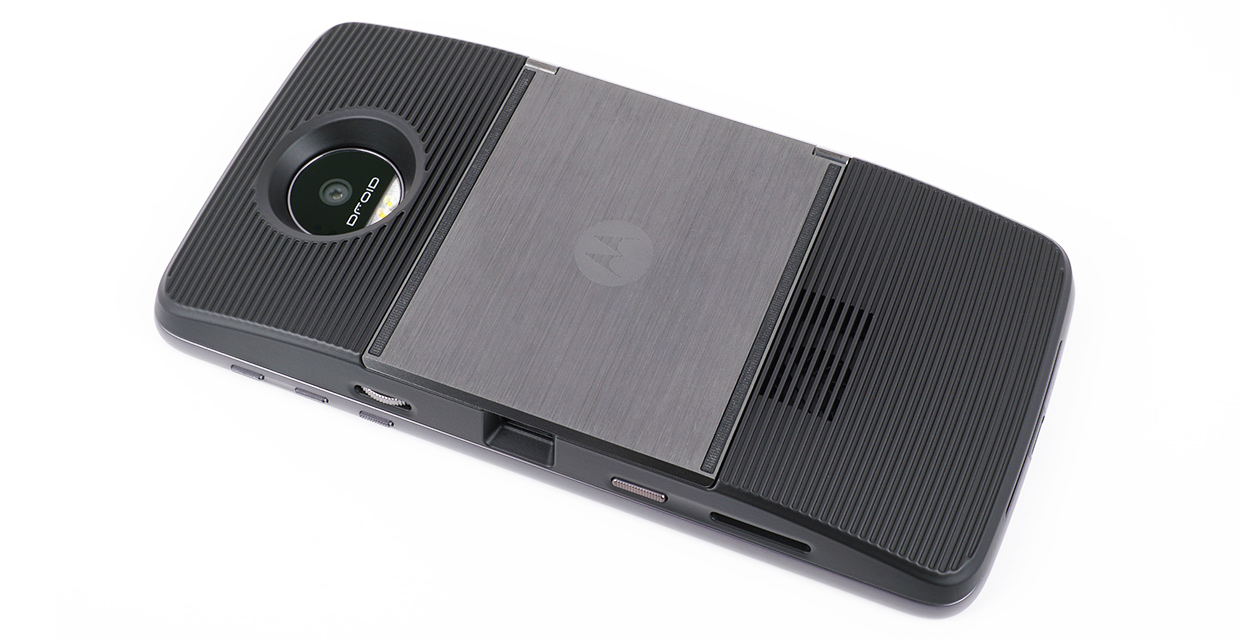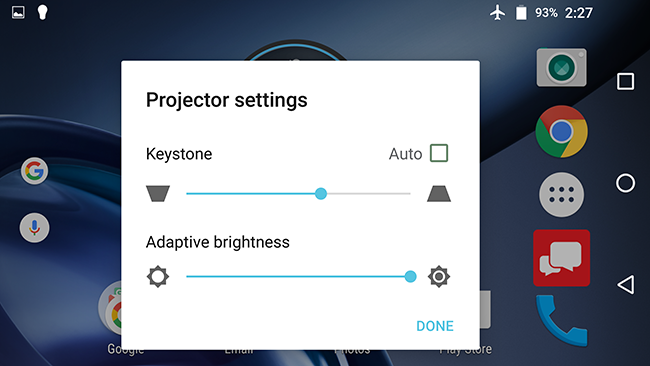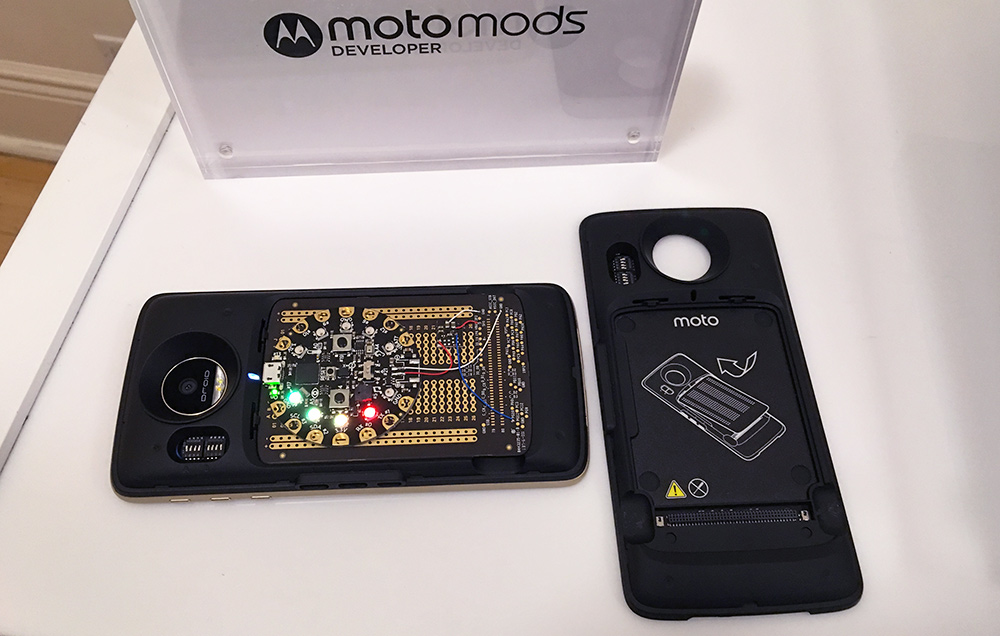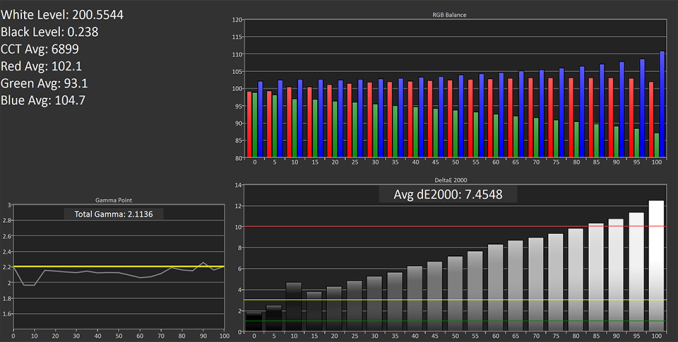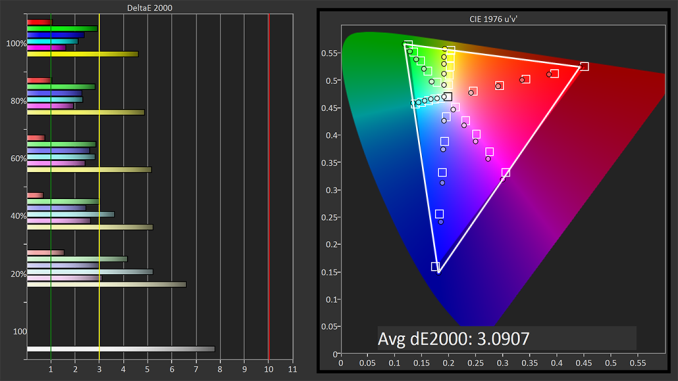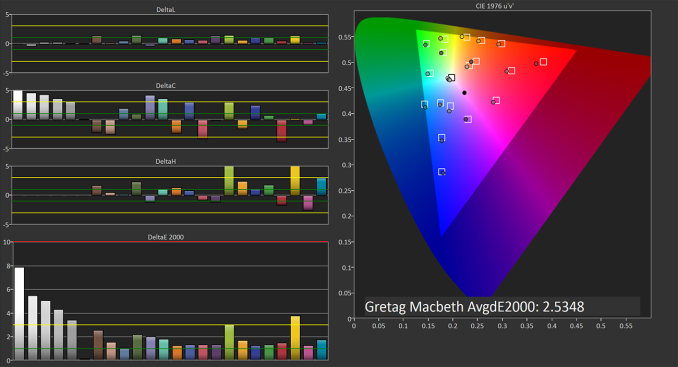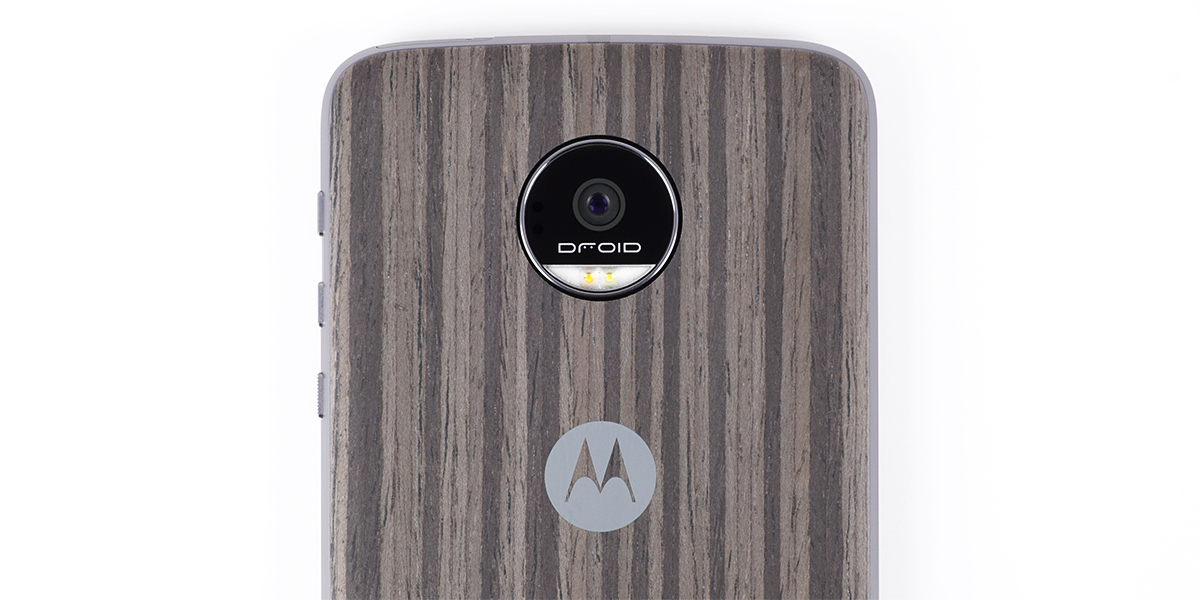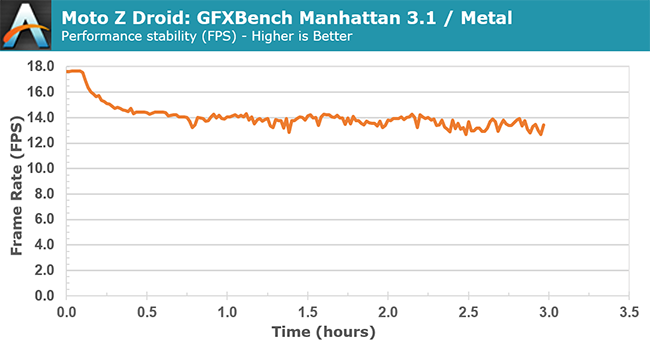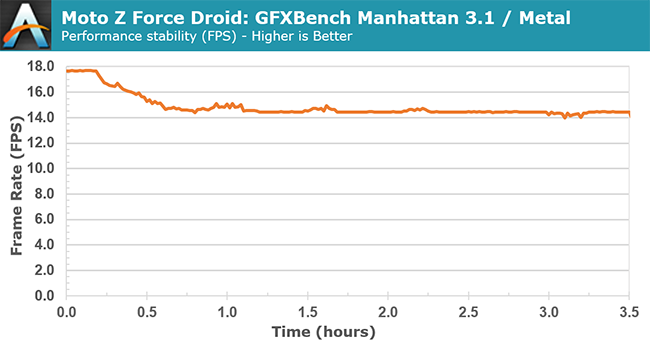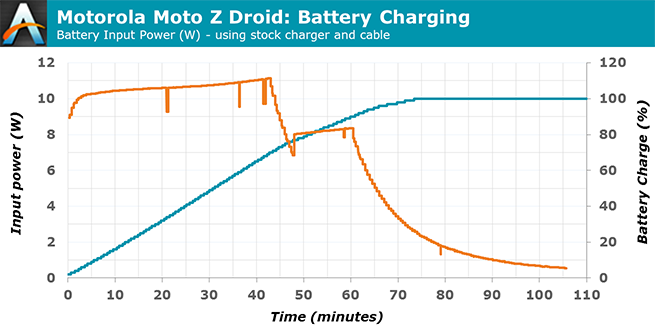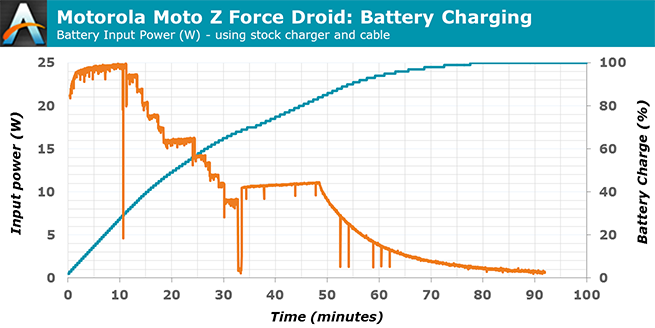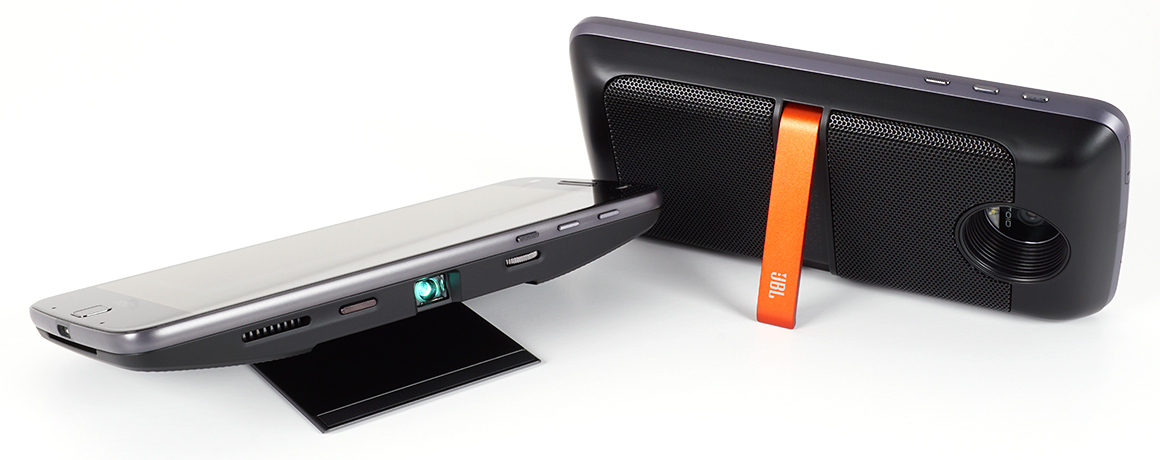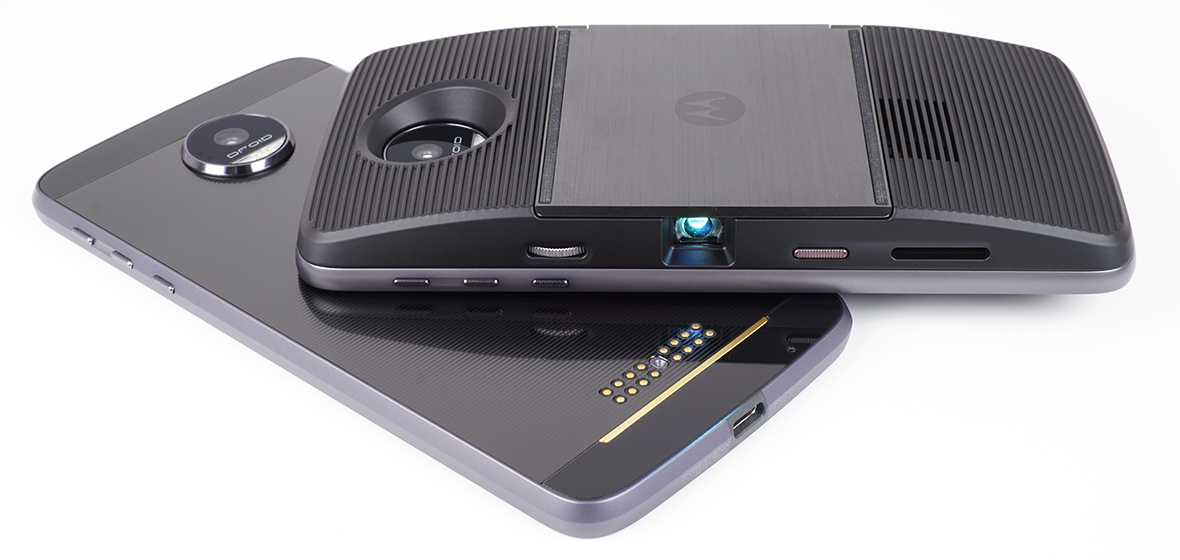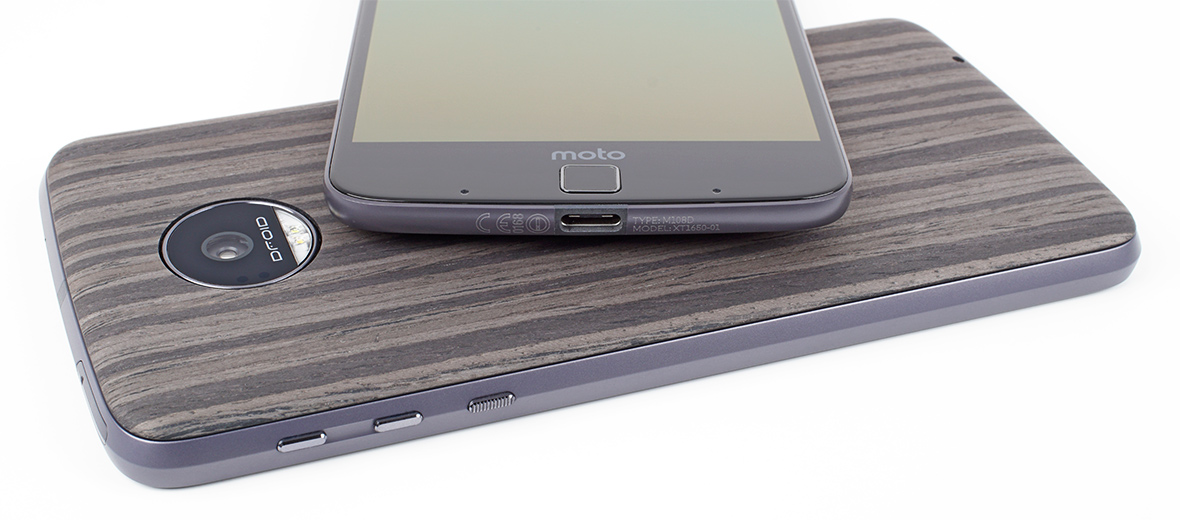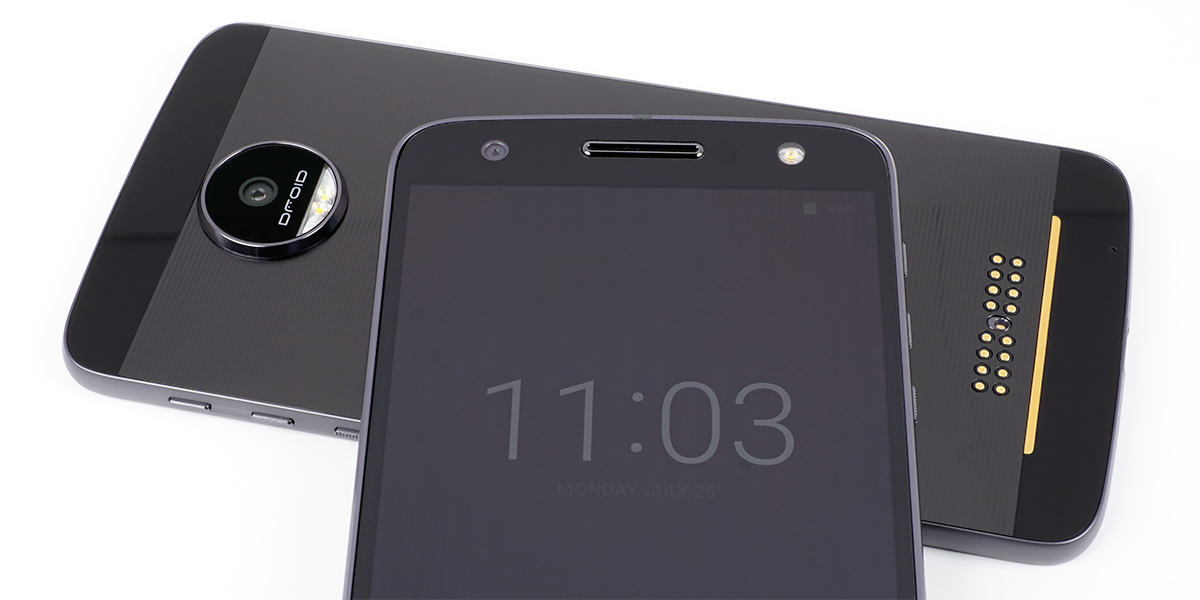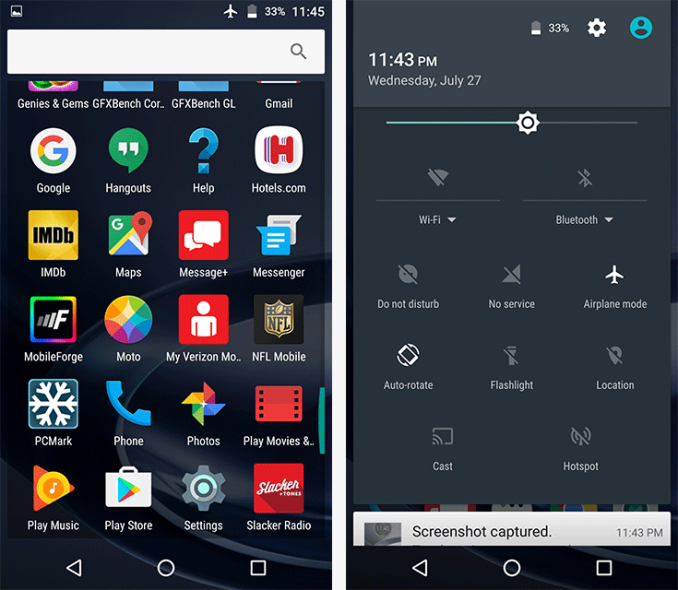
Original Link: https://www.anandtech.com/show/10493/motorola-moto-z-force-droid-review
The Motorola Moto Z & Moto Z Force (Droid Editions) Review
by Matt Humrick on July 28, 2016 8:00 AM EST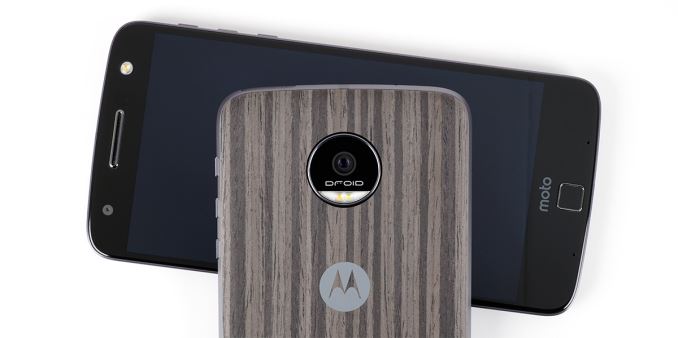
The relationship between Motorola and Verizon dates back to 2009 and the original Motorola Droid smartphone. Since then, the two companies have paired up for a number of Droid branded phones that are either only available from Verizon initially or are slightly tweaked models sold only by Verizon. When Motorola announced that the Moto Z and Moto Z Force will be replacing the Moto X family as the company's flagship devices at Lenovo’s Tech World event in June, it came as no surprise then that both phones would continue the Droid legacy and land exclusively on Verizon’s network first.
Unlocked versions of the Moto Z and Moto Z Force will be available directly from Motorola before the end of the year, but instead of waiting for the general release, we decided to go hands-on with Verizon’s Droid Editions, which use identical hardware.
| Motorola Moto Z Droid Family | ||
| Moto Z Droid | Moto Z Force Droid | |
| SoC | Qualcomm Snapdragon 820 (MSM8996) 2x Kryo @ 2.15GHz 2x Kryo @ 1.59GHz Adreno 530 @ 624MHz |
Qualcomm Snapdragon 820 (MSM8996) 2x Kryo @ 2.15GHz 2x Kryo @ 1.59GHz Adreno 530 @ 624MHz |
| RAM | 4GB LPDDR4-3188 | 4GB LPDDR4-3188 |
| NAND | 32GB / 64GB (UFS 2.0) + microSD |
32GB / 64GB (UFS 2.0) + microSD |
| Display | 5.5-inch 2560x1440 SAMOLED Corning Gorilla Glass |
5.5-inch 2560x1440 SAMOLED Moto ShatterShield |
| Dimensions | 153.3 x 75.3 x 5.19 mm 136 grams |
155.9 x 75.8 x 6.99 mm 163 grams |
| Modem | Qualcomm X12 (Integrated) 2G / 3G / 4G LTE (Category 12/13) |
Qualcomm X12 (Integrated) 2G / 3G / 4G LTE (Category 12/13) |
| SIM Size | NanoSIM | NanoSIM |
| Front Camera | 5MP, 1/4" OmniVision OV5693, 1.4µm pixels, f/2.2, Auto HDR, LED flash | 5MP, 1/4" OmniVision OV5693, 1.4µm pixels, f/2.2, Auto HDR, LED flash |
| Rear Camera | 13MP, 1/3.06" Sony IMX214 Exmor RS, 1.12µm pixels, f/1.8, Laser AF, OIS, Auto HDR, dual-color LED flash | 21MP, 1/2.4" Sony IMX338 Exmor RS, 1.12µm pixels, f/1.8, PDAF + Laser AF, OIS, Auto HDR, dual-color LED flash |
| Battery | 2600 mAh non-removable |
3500 mAh non-removable |
| Connectivity | 802.11a/b/g/n/ac 2x2 MIMO, BT 4.1 LE, NFC, GPS/GNSS, USB Type-C, Moto Mods connector | 802.11a/b/g/n/ac 2x2 MIMO, BT 4.1 LE, NFC, GPS/GNSS, USB Type-C, Moto Mods connector |
| Launch OS | Android 6.0.1 | Android 6.0.1 |
| Launch Price (No Contract) |
$624 ($26/mo) / $674 | $720 ($30/mo) / $770 |
Just like we’ve seen with most other flagship phones from this generation, the two Moto Z Droids come with Qualcomm's Snapdragon 820 SoC and 4GB of LPDDR4 RAM. Both models have either 32GB or 64GB of UFS 2.0 NAND, although the 64GB option is only available online through Motorola’s Moto Maker website. Internal storage can also be expanded with microSD cards. The Moto Z Droids have wireless connectivity covered with Qualcomm’s latest X12 baseband processor integrated into the SoC, Bluetooth 4.1 LE, NFC, and 802.11ac 2x2 MIMO Wi-Fi.
Unlike the Moto X phones, the Moto Z Droids come with a touch-based fingerprint sensor, a convenient security feature for unlocking the phone, authorizing purchases, and making mobile payments with Android Pay. So far I’ve found the new fingerprint sensor to be very reliable, unlocking the phone extremely quickly regardless of finger position. As with other capacitive sensors, it still has trouble with moisture and large changes in temperature, but its sensitivity to environmental factors is no worse than other solutions.
Neither of the Moto Z Droids support wireless charging, but they do include Motorola’s TurboPower fast-charging technology, which uses the included 15W or 30W chargers to provide up to 8 or 15 hours of battery life in just 15 minutes for the Moto Z Droid and Moto Z Force Droid, respectively, according to Motorola. Another shared feature is a water-repellant nano coating that protects the phones from accidental spills or light rain, but does not provide actual water or dust proofing like Samsung’s IP68 rated Galaxy S7.
While much of the internal hardware is the same, there are a few notable differences between the two models, the most significant being battery size. The Moto Z Droid comes with a 2600mAh battery, which is below the roughly 3000mAh average for phones with 5.5-inch displays. The Moto Z Force Droid bumps battery capacity to 3500mAh, which brings it close to the 3600mAh battery in Samsung’s Galaxy S7 edge. Differences in software and display efficiency will likely determine if the Force Droid can outlast the Galaxy S7 edge.
Both Moto Z Droids have the same 5MP front-facing camera with wide-angle lens that uses a dedicated LED flash and automatic HDR imaging to help capture selfies over a wider range of lighting conditions. The rear cameras both have large f/1.8 apertures and optical image stabilization to improve low-light image quality, but they use different sensors and autofocus systems. The Moto Z Droid includes a 13MP Sony sensor that pairs standard contrast-based autofocus with a laser to improve focus performance in low light. The Moto Z Force Droid uses a more advanced 21MP Sony sensor with deep trench isolation (DTI) technology for improved color fidelity. It also uses a hybrid autofocus system that combines laser, phase detection (PDAF), and contrast detection methods, which should provide faster, more reliable focusing performance in a variety of lighting conditions.
While the Moto Z Droid’s screen is covered edge to edge with Corning Gorilla Glass, the Moto Z Force Droid uses Motorola's second-generation Moto ShatterShield technology, a five-layer system that starts with an aluminum panel as a base to keep the 5.5-inch AMOLED screen from flexing. Two separate touch layers above the display provide redundancy in case one of the layers is damaged. A clear, flexible lens, likely made from a polycarbonate, is next. A second protective lens with a proprietary hardcoat completes the display stack. This assembly improves the screen's resistance to cracking or shattering if dropped, which Motorola backs by a four-year warranty.
The new Moto Z Droids’ specifications and hardware are impressive but not that much different than what’s currently available with other flagships. To make its new phones more enticing, Motorola made them modular. The idea of easily swappable accessories that extend a phone’s functionality shows promise but has not fully materialized—at least not yet. Will Motorola’s Moto Z and its modular accessories, called Moto Mods, prove useful or will they just be another wacky idea that goes nowhere?
Design
Motorola has used a common design language for its phones over the past few generations—rounded backs, minimal bezels, and the iconic circular dimple. Customization through Motorola’s Moto Maker website has also been a differentiating feature for its phones. Last year’s Moto X, for example, offers different color combinations for its aluminum frame, front bezel, and metal accent pieces. It also has swappable back covers that come in different colors and materials, allowing the phones to be highly personalized.
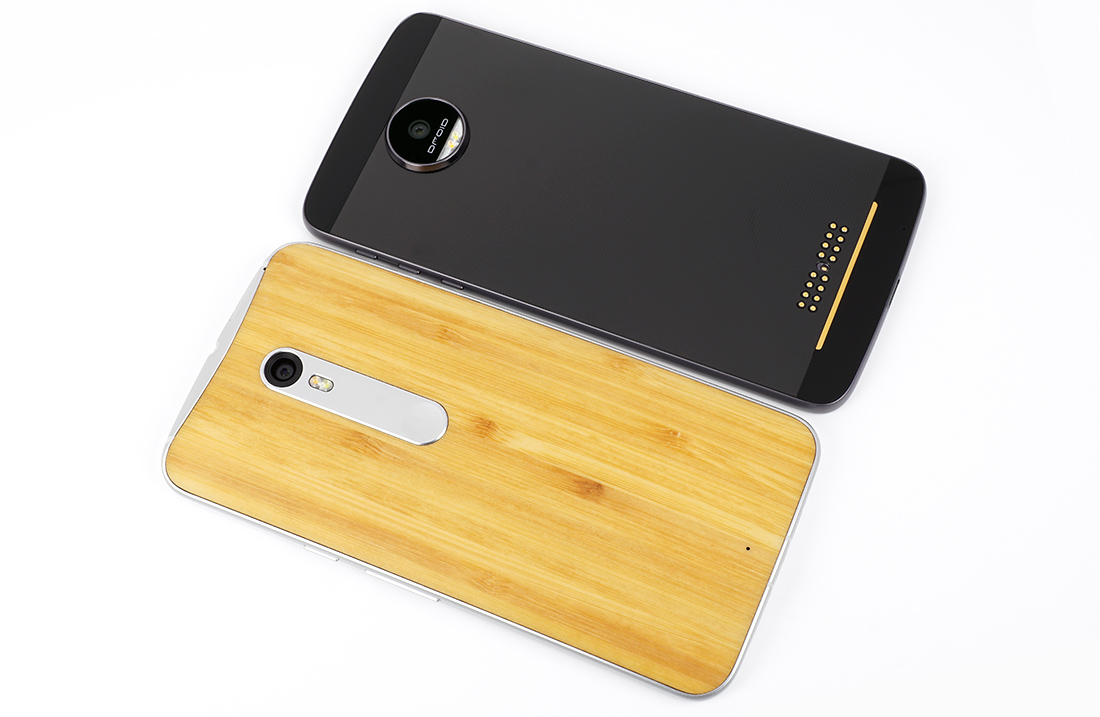
Out with the old, in with the new: Moto X Pure Edition (bottom) and Moto Z Droid (top)
Motorola’s newest flagship phones still use an aluminum frame and allow some customization through Moto Maker, but are otherwise a radical departure from previous phones. The biggest changes are around back, but even the front of the Moto Zs show obvious differences. The lower bezel is now significantly larger than what’s found on the Moto X models; even the side bezels are a little thicker.
The square fingerprint sensor is primarily to blame for the bump in bezel size. I already mentioned how well it fulfills its primary function: Touching the sensor with an enrolled digit instantly wakes and unlocks the phone. It can also turn off the display and lock the phone by touching it with any finger, even if it has not been explicitly enrolled. Using the fingerprint sensor in this way is analogous to double-tapping the screen to wake or lock the phone and is more convenient than using the power button. Unlike most front-mounted fingerprint sensors, though, it does not function as a home button. Instead, the Moto Z Droids use onscreen navigation buttons. Sure, soft buttons hold some advantages, but they take up valuable screen space, and not using capacitive buttons here seems like a mistake when there’s so much extra room in the lower bezel.
On each side of the fingerprint sensor is a small microphone and an infrared motion sensor that activates Moto Display when you wave your hand over the phone. The circuitry for the display apparently sits behind the lower bezel, adding to its overall height and making room for a “moto” logo that’s reminiscent of past HTC designs.
A sufficiently large earpiece, which also does double duty as a mono front-facing speaker, is centered above the display. The ambient light and proximity sensors sit just to the right of the speaker. The 5MP front-facing camera sits in the upper-left corner, while an LED selfie-flash, a feature that’s still relatively unique, sits in the opposite corner. There is no additional motion sensor for Moto Display in the Z’s upper bezel like there is in the Moto X phones.
As similar as the two Moto Zs are, there a couple of minor design differences. First, the Moto Z Droid’s edge-to-edge cover glass has a slight bevel around the perimeter, giving edge swipes a smooth feel. The edge of the Moto Z Force Droid’s ShatterShield cover is not curved; it’s completely contained within the aluminum frame’s raised lip, instead. Second, the sides of the aluminum frame have a different shape. The thinner Droid has a smooth, tapered edge, whereas the Force Droid has dual tapers that meet in a raised ridge. This difference is more form than function, because it does not make the phone easier to hold or pickup.
The top edge is home to another microphone (there’s a fourth one on the back) and the combination NanoSIM and microSD card tray, with a plastic antenna line in the middle. The only feature on the bottom edge is the USB Type-C port. Notably absent is a 3.5mm headphone jack, which means you’ll need to go wireless or use the included USB adapter cable—a part many will likely forget or lose. Call me old fashioned, but I like being able to plug in some headphones or external speakers and listen to music while charging the phone at the same time. I guess it’s inevitable, though, that Bluetooth or USB Type-C will replace the aging, analog headphone jack.
All of the buttons lie on the right edge towards the top, reducing the likelihood of pressing them accidentally when handling the phone. The individual volume buttons sit inside a scalloped slot, while the nicely textured power button is directly below. Because the Moto Z Droid is so thin, its buttons are actually smaller, giving them a sharper feel similar to the Galaxy S6 edge. The buttons fit snugly in the frame and make a solid click when pressed.
The back of the phones are designed to accommodate the Moto Mod accessories. Along the bottom of the completely flat back are a series of exposed gold pins that form the Moto Mod connector for sharing data and power with the modules. The circular camera housing sticks out pretty far, and is the only place we see any Verizon or Droid branding.
What's weird, though, is that the back is not just unfinished black plastic or metal. Motorola actually dresses it up with a lined pattern, Motorola logo, and color-matching plastic inserts at the top and bottom for the antennas. It's almost as if Motorola expects people to use these phones with nothing attached to the back. But with the exposed Moto Mod connector, a huge camera hump, and sides that do not blend nicely into the back, the phones just look … naked.
Fortunately, there's a series of decorative plates called Style Shells that snap onto the back to preserve the phones’ modesty. They also sit flush with the rear camera, and their curved surface blends better with the sides, making the phones much more comfortable to hold. The Style Shells start at $14.99 and come in several colors and materials that customize the look and feel of the new Droids, including real wood and fabric for $19.99 and real leather for $24.99. Both of our review units came with the Charcoal Ash wood shell.
The Moto Z Droids are not as customizable as the Moto X phones, however. The ability to mix and match pieces is gone, replaced by three color combination choices: Lunar Grey frame with black front and back (like our review units), Rose Gold frame with black front and back, and a Fine Gold frame with gold back and white front.

Moto Z Force Droid (left) and Moto Z Droid (right)
The most controversial of Motorola’s design changes—large camera hump, missing headphone jack, and smaller battery (at least for the Moto Z Droid)—are the result of making the new phones as thin as possible. The Moto Z Droid is only 5.19mm thick (excluding the camera hump), while the Moto Z Force Droid is a more common 6.99mm because of its larger battery. In this case, however, Motorola’s obsession with thinness extends beyond a bullet point on a marketing slide; it’s a necessary concession to enabling its vision for a modular smartphone.
Moto Mods
In a bold move to set the Moto Z apart from the staggering assortment of smartphones currently available, and to bolster its bottom line by selling higher profit margin accessories, Motorola has gone modular. Unlike LG’s approach with the G5 that requires the battery to be removed and the phone rebooted when swapping modules, Motorola’s Moto Mods attach to the back of the phone with strong magnets and are hot swappable.
The modules are also tightly integrated with the software. Attaching a Moto Mod produces a small vibration and audible alert confirming that it has been automatically recognized. For any Mods with internal batteries, there’s a notification that pops up showing the charge level, which also appears in the battery section within the settings app and in the notification shade. There’s a dedicated “Moto Mods” page also in settings for updating the Mod’s firmware, managing its settings, and reading its instructions.
Regardless of what I think of the Mods themselves, Motorola’s execution of the modular phone is very good. The magnets hold the Mods firmly in place without making them too difficult to remove, the tight software integration makes them feel like they’re really part of the phone, and the ability to hot-swap the modules without rebooting or going through a setup procedure makes them convenient to use. My only criticism is that the metal pin on the back of each Mod and Style Shell that keeps them from sliding off the phone (it fits into a small hole on the back of the phone in the middle of the Moto Mod connector) can scratch the back of the phone if you’re not careful.
So what about the Mods themselves? There’s three to choose from initially: the Moto Insta-Share projector, the JBL SoundBoost speaker, and a series of Power Packs that add an additional 2220mAh of battery capacity. The Power Packs range in price from $59.99 to $89.99 and come in several different designs, including a brushed black finish from TUMI, solid black and solid white from Incipio, and black and white stripes from Kate Spade. Each design comes in both a standard and wireless charging version, with the latter supporting the Qi 1.2.1 and PMA 3.0 standards. The Power Packs add an additional 6.2mm of thickness to the phones and either 79g of weight for the standard version or 85g for the wireless charging version. The Moto Z Droid wears the additional bulk well—it basically feels like a slightly heavier Moto X that fits in the hand comfortably; however, at a combined 13.2mm and 242g, the Moto Z Force Droid definitely weighs down your pocket.
After attaching the Power Pack, it begins charging the phone’s battery and keeps it at 100% until it’s drained. There’s also an “Efficiency Mode” that’s supposed to increase battery life by up to 20% by only charging the phone once it drops below 80% instead of keeping it topped off. The standard Power Packs can only be charged while they are attached to the phone, but the wireless versions can be charged either attached to the phone or separately. I had no issues charging either Droid with Power Pack attached using standard 5W chargers or a Mophie external battery.
The JBL SoundBoost speaker has two 27mm diameter drivers powered by up to 3W each. There’s a built-in aluminum kickstand on the back with a rubber foot that snaps out and props up the phone, and it also includes its own 1000mAh battery that provides an additional 10 hours of music playback (with the screen turned off). The speaker Mod even has a USB Type-C port for charging it separately from the phone.
With a thickness and weight of 13mm and 145g, it creates a hefty package when attached to either phone that’s better suited for carrying in a purse or backpack than a pants pocket. Its tapered sides blend in nicely with the Moto Z’s frame, and it actually feels comfortable to hold, although, your arm will tire quickly trying to hold this beast to your ear during a phone call; with this Moto Mod attached, it’s best to take advantage of the kickstand and leave the phone sitting on a table.
The smartphone’s strength lies in its portability, so an add-on module that makes a phone less portable does not make a lot of sense. It makes even less sense when it costs $79.99 and provides rear-firing speakers that, while a significant upgrade over the Moto Z’s speaker, are easily bested by similarly priced Bluetooth speakers that can be aimed in any direction or placed anywhere within earshot. The only thing the JBL SoundBoost speaker Mod provides that a Bluetooth speaker does not is a kickstand for propping up the phone, which is not enough to justify its price and reduced mobility.
The Moto Insta-Share projector Mod is a nicely designed accessory that succumbs to the laws of physics. At 11mm and 125g it’s just slim and light enough to carry around attached to the Moto Z Droid, but feels bulky on the back of the Force Droid. Motorola claims that its built-in 1100mAh battery adds 1 hour of projection time before using the phone’s battery. This gives the Moto Z Droid and Moto Z Force Droid an estimated 2.5 and 4 hours, respectively, of total runtime using the projector. The projector can be charged through the phone when attached or independently with the USB Type-C port on its side. Like the Power Packs, there’s a button on the backside that lights a small LED when pressed that indicates the charge level, a handy feature for quickly checking the battery status when it’s not attached to the phone.
The module’s metal foot has rubber strips to help keep it from sliding around, and its hinge is stiff enough to hold the phone at any angle up to 90°. The projector’s controls are on either side of its lens—a power button, which has the same texture as the Moto Z’s, and a focus wheel, which is inconveniently placed directly below the phone’s power button, making it more difficult to use. The whole module is encased in a soft, rubberized coating.
The projector itself uses DLP technology to project a 480p (854x480) image at 50 lumens nominal—bright enough for a darkened room or even indoors with a trace of ambient sunlight, but nowhere near bright enough for even a moderately lit room. Even with its relatively low output, the projector gets pretty warm during use and requires a small cooling fan that’s audible during quiet moments.
Tapping the projector’s power button when it’s turned on opens an onscreen menu for adjusting brightness and vertical keystone correction. Using the phone’s onboard sensors, it can automatically correct the trapezoidal distortion that results from projecting a rectangular image onto an angled surface at angles up to ±40°. Occasionally, I had to adjust for keystone manually, because the automatic correction would not fully compensate.
Even in a completely dark room the image quality is not great. Downsampling the display's native QHD resolution to VGA creates obvious aliasing and jagged text. The projector’s 400:1 contrast ratio further limits the quality of photos and videos, where grayscale gradients are replaced by solid black fields. The Moto Insta-Share projector can handle an impromptu business presentation or entertaining the kids in a pinch, but it’s a difficult sell when there’s standalone pico projectors that perform better and cost the same or less than its $299.99 asking price. Is it really worth paying more for less performance just to have it attach to the back of the phone?
Ultimately, Motorola’s modular platform will not live or die based solely on these initial Moto Mods, but on whether or not any other companies jump on board and develop additional modules with more unique functionality. For its part, Motorola seems committed to its platform, stating that current Moto Mods will work on future products at least one generation out. It also offers a Moto Mods Development Kit (MDK) that includes a breadboard, which fits into a reference Moto Mod, and a cover to enclose the circuitry. Motorola says additional Moto Mods are currently in development, and lists several intriguing possibilities such as secondary displays (either LCD or E Ink), printers, blood pressure monitors, or infrared cameras. Based on what I’ve seen to date, I’m still not sold on the modular smartphone concept. But Motorola’s Moto Mod system is the best approach yet, and there’s still a chance it may succeed.
Display
Motorola cannot seem to settle on a single display size or technology. The second-generation Moto X used a 1080p (FHD) 5.2-inch AMOLED panel. It then switched to IPS LCD panels for last year’s Moto X family, increasing the size and resolution of the Moto X Pure Edition’s display to 5.7-inches and 1440p (QHD). For its Moto Z phones, Motorola goes back to using AMOLED displays but with a 5.5-inch size and a QHD (2560x1440) resolution that is dense enough that most people will not be able to notice the subpixel arrangement.
While we measured the display performance for both the Moto Z Droid and Moto Z Force Droid with an X-Rite i1Pro 2 spectrophotometer and an i1Display Pro colorimeter for brightness and contrast measurements, the results were very similar; therefore, we will only show the Moto Z Droid in the charts below to reduce clutter.
Even though the two Moto Z displays look nearly the same to our test equipment, there is a subtle difference that’s perceptible with our eyes. The extra layers in the Moto Z Force Droid’s Moto ShatterShield display introduce a slight grain or sparkle reminiscent of the anti-glare treatment applied to some LCD displays. The effect is not severe, but it is noticeable when looking at the two displays side by side.
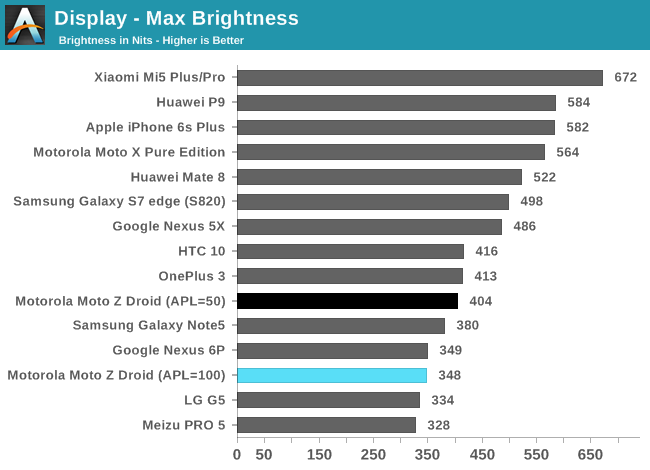
The Moto Z Droid reaches a peak brightness of about 350 nits when using the manual brightness mode, which is similar to the AMOLED panels in the Nexus 6P and Meizu PRO 5 but a little shy of the Galaxy Note5’s 380 nits and OnePlus 3’s 413 nits. At 50% APL peak brightness increases to 404 nits, but it’s still well below the 500 to 600 nits LCD panels are capable of. The minimum brightness is about 15 nits.
Like Samsung’s Galaxy phones, the Moto Z Droids have a boost feature when using auto-brightness mode that increases peak brightness to 504 nits, similar to the Galaxy S7 edge, for a short period of time in direct sunlight. At 50% APL the boosted brightness reaches 591 nits. While viewing the display outside can be difficult when setting brightness manually, the auto-brightness boost puts the Moto Z Droid’s display on par with most LCD screens for outdoor visibility.
The Moto Z Droids boast a black level equal to zero, because their AMOLED panels can completely turn off individual pixels. This gives them a mathematically infinite contrast ratio, although reflections on the cover glass reduce the effective contrast ratio for all displays.

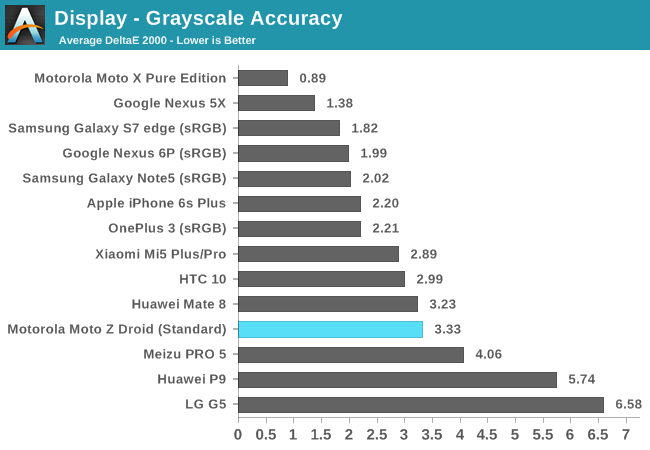
The Moto X Pure Edition has an exceptionally well-calibrated display when using its “Normal” mode, as shown in the charts on this page. After hearing about the switch to AMOLED for the Moto Zs, I was concerned that display accuracy may regress. Many OEMs use the OLED panel’s naturally wider color gamut to display more saturated, vibrant colors, even though they do not match the rendering intent of the source material. Thankfully, Motorola still includes two different color modes; the “Standard” mode is calibrated for the sRGB color space—which most smartphone content targets and is the only color space Android understands—and should satisfy the customers looking for an accurate display, while the “Vibrant” mode uses a wider gamut that, true to its name, produces brighter colors for people that prefer a more lively display.
It seems more OEMs are realizing that their customers perceive display performance differently and are providing options to adjust parameters to their liking. Samsung has provided different display modes for several generations too, and both Google and OnePlus added an sRGB mode to the Nexus 6P and OnePlus 3. Meizu, Xiaomi, and others at least provide some basic control over the display’s white point. It’s good to see some companies take display quality more seriously and give us more control over the light reaching our eyes.
Perhaps Motorola should add a color temperature slider too, because both the Moto Z Droids’ Standard and Vibrant modes have a white point above 7,000K, giving lighter shades of gray a noticeable blue tint. In the Standard mode, ΔE2000 grayscale error is actually pretty good from black up to about 65% luminance, staying at or below 3, which is the threshold where error becomes readily apparent. Grayscale error ramps up more quickly in the Vibrant mode because of its cooler white point, reaching a peak ΔE2000 error of around 8 between 70% gray and 100% white. While grayscale accuracy is not bad in the Standard mode, it’s still a step back from the Moto X Pure Edition and falls behind several other flagship phones. Grayscale performance in Vibrant mode is definitely disappointing, however.

The Moto Z Droids’ Standard mode adheres pretty closely to the sRGB color space, but it does slightly miss each corner point. Color saturation levels are generally good except for blue, which shows mild oversaturation. The imbalance between the blue and red primary colors, which we saw in the grayscale results, leads to a shift in hue for the secondary colors yellow and magenta. Overall, ΔE2000 error remains at or below 3 above 40% saturation if we overlook the yellow shift, which is not too bad; however, once again the Moto Z Droids fall behind the Moto X Pure Edition and the sRGB modes of several other current flagships.
The Vibrant mode covers a much larger gamut, extending beyond the sRGB color space with all three primaries and providing roughly 10% to 20% higher saturation levels for most colors. It’s enough to make colors look more intense without going too far and making them look cartoonish.
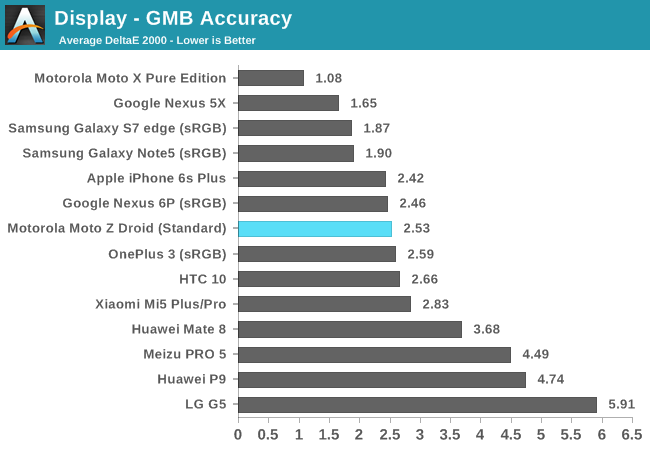
Despite the grayscale issues, the Moto Z Droids show pretty good color accuracy when using the Standard mode, with most measured colors at or below a ΔE2000 error of 3, which is comparable to the iPhone 6s Plus, Nexus 6P, HTC 10, and OnePlus 3.
AMOLED displays generally exhibit more color shift but less luminance variation than IPS LCDs when viewed from different angles. This holds true for the Moto Z Droids that both exhibit color shifting similar to the Galaxy S7 edge. The color shift becomes noticeable at about a 45° angle to both the horizontal and vertical axes. The Moto Z Force Droid also shows a rainbow pattern when viewed from the side that’s not visible on the Moto Z Droid or other AMOLED displays, presumably from one of the extra layers in its ShatterShield display. The Moto Z Droid has its own unique issue: It has a severe magenta color shift at extreme viewing angles in both directions. This will not be an issue during normal use, however.
The new AMOLED displays in the Moto Z Droid and Moto Z Force Droid look very good but calibration issues hold them back from achieving their full potential. Black levels, brightness, and viewing angles are generally comparable to other flagship phones using AMOLED panels, and besides the cooler than ideal white points for both the Standard and Vibrant modes that hurt grayscale accuracy, there are not any other major issues with display performance.
Camera Hardware
The Moto Z Droid comes with a 13MP Sony IMX214 Exmor RS rear camera sensor. This 1/3.06" format CMOS sensor with 1.12µm pixels is backside-illuminated and uses a stacked die. Images are captured with a 4:3 aspect ratio at its native resolution.
The Moto Z Force Droid increases resolution to 21MP by using Sony’s IMX338 Exmor RS sensor for its rear camera. This is also a backside-illuminated CMOS sensor with a stacked die and 1.12µm pixels, but adds deep trench isolation (DTI) technology to reduce electrical crosstalk and improve color fidelity by placing physical barriers between each pixel. The larger 1/2.4" format sensor also uses a 4:3 aspect ratio.
| Camera Architecture | ||
| Moto Z Droid | Moto Z Force Droid | |
| Front Camera: Resolution | 5MP | 5MP |
| Front Camera: Sensor | OmniVision OV5693 (1.4µm, 1/4") |
OmniVision OV5693 (1.4µm, 1/4") |
| Front Camera: Focal Length | 2.45mm (23mm equivalent) | 2.45mm (23mm equivalent) |
| Front Camera: Aperture | f/2.2 | f/2.2 |
| Rear Camera: Resolution | 13MP | 21MP |
| Rear Camera: Sensor | Sony IMX214 Exmor RS (1.12µm, 1/3.06") |
Sony IMX338 Exmor RS (1.12µm, 1/2.4") |
| Rear Camera: Focal Length | 3.68mm (27mm equivalent) | 4.51mm (26mm equivalent) |
| Rear Camera: Aperture | f/1.8 | f/1.8 |
Both rear cameras have a dual-color LED flash to improve color accuracy and optical image stabilization (OIS) to reduce motion blur from shaky hands, which is particularly important for longer exposures in low-light conditions.
The Moto Z Droid uses a hybrid autofocus (AF) system that combines laser AF and contrast AF. The laser AF system uses an infrared laser and its own light sensor to make time-of-flight calculations to quickly determine focus distance in low-light conditions. The laser has a limited range, however, and can be overpowered by environmental sources. In our experience, laser AF is fast when it works, but the slower contrast AF method still ends up doing most of the work.
To overcome these limitations, the Moto Z Force Droid uses a more sophisticated hybrid autofocus system that combines laser and contrast AF with phase detect AF (PDAF), which works well at longer distances and in good lighting. Because their strengths are complementary, using laser AF and PDAF can provide faster, more accurate focusing over a broader range of conditions.
Both Moto Z Droids place a large-aperture lens in front of the rear camera sensor to capture more light, but because of the difference in focal length, the Moto Z Force Droid’s aperture area is 50% larger than its sibling’s, putting it on par with the HTC 10, Galaxy S7, and LG G5, and giving it a 15% advantage over the Moto X Pure Edition and Nexus 6P. The Moto Z Droid’s aperture area is smaller than all of these phones, but is still 17% larger than the iPhone 6s Plus and the same size as Huawei’s P9.
Both Moto Zs use the same 5MP OmniVision OV5693 sensor for their front-facing cameras, which uses larger 1.4µm pixels in a 1/4" format. This is paired with an f/2.2 wide-angle lens and a dedicated LED selfie-flash. The front cameras also support automatic HDR imaging, a convenient feature for improving image quality not seen on many front cameras.
Photo Quality
Motorola’s phones have never had great cameras. Last year it took a step in the right direction by upgrading the hardware in the Moto X phones, but Motorola’s software algorithms limited image quality—heavy-handed noise reduction processing smeared away a significant amount of detail.
The Moto Zs get new camera hardware once again along with a new camera app. Did software processing receive an upgrade too? To find out we’ll compare photos from both Moto Z Droids to several other flagship phones, including the iPhone 6s Plus, Nexus 6P, and Galaxy S7, which all use different 12MP Sony sensors. The LG G5 uses a 16MP Sony IMX234 Exmor RS sensor, while last year’s Moto X Pure Edition employs the higher resolution 21MP Sony IMX230 Exmor RS. All of the phones have OIS except the Moto X PE and Nexus 6P.
| Daylight Photo Comparison 1 |
In this first set of daylight images, the Moto Z Force gets both the exposure and white balance correct. The Moto Z does pretty well with white balance but its smaller aperture area coupled with a faster shutter speed results in a slightly underexposed image. Both Moto Z images look better than the Moto X PE’s underexposed image with a cool white balance.
The Moto Z Force, Nexus 6P, and Galaxy S7 capture the most detail in this scene. The Moto Zs, like most smartphones, apply an unsharp mask to sharpen edges and increase perceived detail, although it’s not as strong as the Galaxy S7’s processing and does not create any noticeable haloing artifacts. Despite having a 21MP camera like the Moto Z Force, the Moto X PE’s noise reduction processing wipes away some of the finer detail. Unable to focus properly, the Moto Z captures an image that’s blurry across the whole frame.
The Moto Z’s image shows considerably more purple fringing in the trees and along the fence than the Moto Z Force’s, which appears to be a byproduct of image processing. The Moto Z Force keeps noise to a minimum, similar to the other flagships, but the Moto Z’s noise pattern in the sky shows some purple splotches that affect color balance on a macro scale.
| Daylight Photo Comparison 2 |
This second daylight scene emphasizes neutral color tones with less green and blue like the previous scene, which presents a different challenge for a camera’s white balance algorithm. All of the phones handle this scene pretty well, though, except for the Moto X PE, whose image has a yellow tint, and the Nexus 6P, which underexposes again. The Galaxy S7 and LG G5 are a little too bright, decreasing color saturation on the red awning and brick facade, but it’s not something that’s noticeable outside of a side-by-side comparison. Both Moto Zs set exposure and white balance correctly and show properly saturated colors.
The Moto Z Force captures the most detail in this scene and arguably the best picture of the group. The iPhone 6s Plus shows a decent level of detail as well, but the Moto Z and the other phones all smooth away fine features with noise reduction processing. This is most evident on the sidewalk and brick wall, particularly in the Galaxy S7 and LG G5 images.
Once again we see purple fringing in the trees, and even a blurry, purple smudge along the power lines, in the Moto Z’s image. The Moto Z Force does not suffer from this issue, so either its software processing is different, its lens has less axial chromatic aberration, or some combination of the two. The Moto Z and LG G5 also show a little more noise than the other phones.
| Evening Photo Comparison 1 |
This set of images were taken after sunset but while there was still a trace of light in the sky. Without OIS, the Moto X PE and Nexus 6P are forced to use faster shutter speeds, 50% and 100% respectively, and capture underexposed images. The iPhone 6s Plus takes the longest exposure, but with the smallest aperture lens of any flagship phone, it still underexposes its image. The two Moto Zs and the Galaxy S7 set exposure correctly. The Moto Z shows less dynamic range than the Moto Z Force and S7, however, by overexposing the bright highlights.
Both the iPhone 6s Plus and Galaxy S7 maintain a good level of detail while keeping noise under control. The Moto Z Force’s image also shows minimal noise, but its noise reduction smears away a bit more detail on the wall in the background and the bricks on the ground. The Moto Z shows more noise and less detail than its bigger brother, but it’s still significantly better than the Moto X PE’s heavily-processed, blurry mess. The LG G5 and Nexus 6P also struggle with noise and detail in this low-light scene.
| Evening Photo Comparison 2 |
The Galaxy S7 performs well in this scene, capturing a naturally bright image, with nice colors, and good detail. The Moto Z Force also does well, but it overexposes the highlights on the front of the building and does not have quite as much detail, although it does show less noise grain. The Moto Z overexposes the highlights on the building too, but it also shows halos around light sources.
It’s difficult to label a single camera as the best because each one excels in different situations; however, based on the pictures I’ve taken, I’d argue that the Moto Z Force has one of the best cameras currently available, which is a huge leap for Motorola. The Galaxy S7 holds a slim advantage in low-light scenes, but the Moto Z Force might be better in bright light.
The Moto Z’s camera is definitely a step behind the Moto Z Force’s in all lighting conditions. Its lower resolution sensor captures less detail and its heavier noise processing reduces detail even further. Just like the Moto Z Force, it does a great job setting exposure and white balance and has nicely saturated colors; however, its images show a fair amount of purple fringing, an aberration the Force avoids, and I noticed a distinct loss of corner sharpness with the Moto Z too.
The Qualcomm Snapdragon 820 SoC inside the Moto Z Droids has proven to be a popular choice for flagship phones this year. Its four custom 64-bit Kryo CPU cores and Adreno 530 GPU are at the heart of nearly every high-end phone currently available. We’ve already tested the performance and battery life of several of these phones, so we already have a good idea of what to expect from the Moto Zs. In this review then, we’ll limit our focus to only a few tests from our usual suite to see how Motorola’s implementation stacks up against its competitors.
System Performance
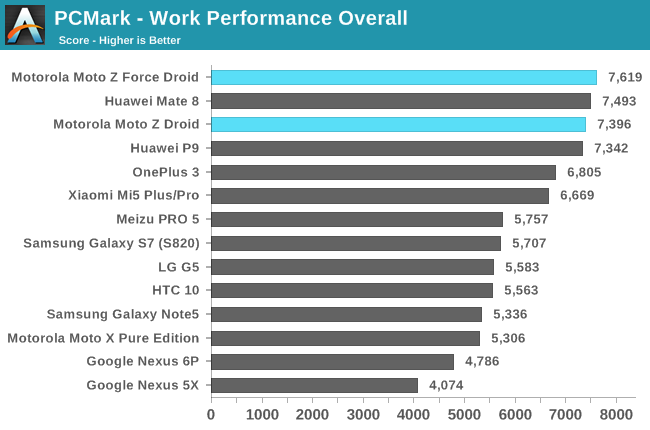
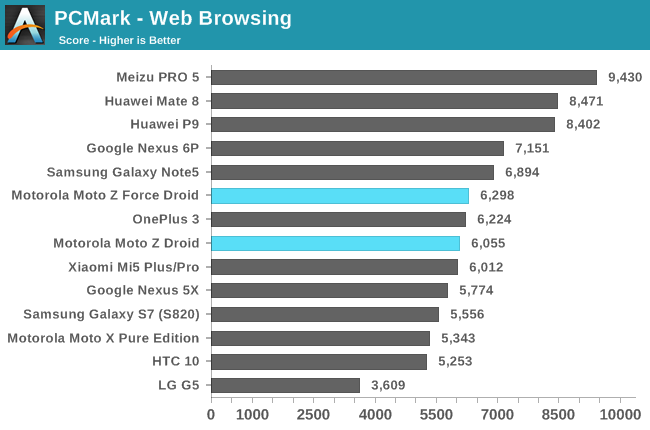
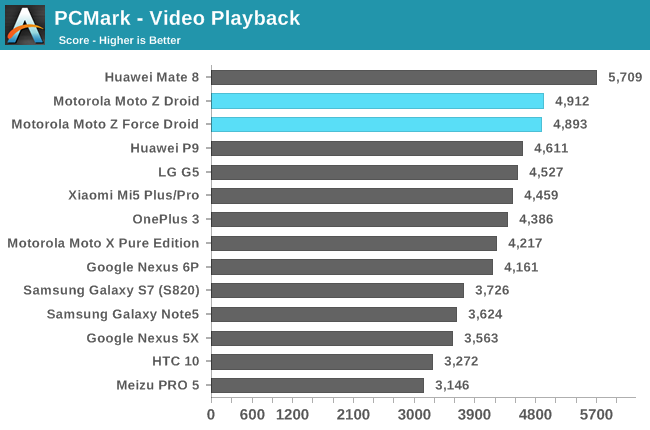
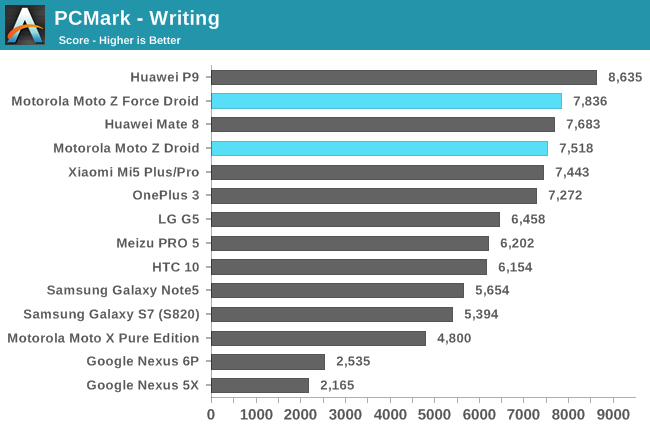
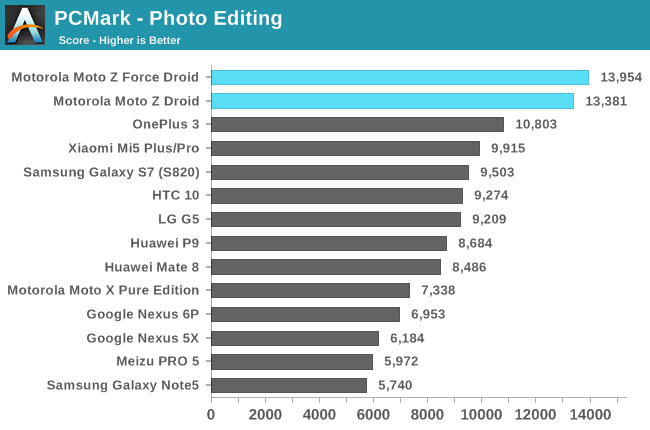
Because PCMark relies heavily on Android API calls to run real-world workloads that exercise the CPU, GPU, RAM, and NAND storage, it’s a good indicator of general system performance for apps we use everyday. Looking first at the overall score, the Moto Z Droid performs quite well, outperforming the other Snapdragon 820 phones and even the Kirin 950/955 in the Huawei Mate 8 and P9.
Diving a bit deeper reveals that most of the Droids’ advantage comes in the Photo Editing test that performs photo processing on the GPU (if supported). Snapdragon 820 generally does well in this test—it occupies all of the top positions in this chart—but the Droids are at least 24% faster than even the OnePlus 3 and 45% faster than the LG G5, which both use the same SoC. The Droids’ performance boost comes from an updated GPU driver.
The Moto Zs also do well in the Video Playback and Writing tests, again outperforming the other phones running Snapdragon 820, albeit by a much smaller margin. The phones using ARM’s Cortex-A57 and -A72 CPUs perform better than those using Qualcomm’s custom Kryo cores in the Web Browsing test, but the Droids are once again the fastest of the Snapdragon 820 group.
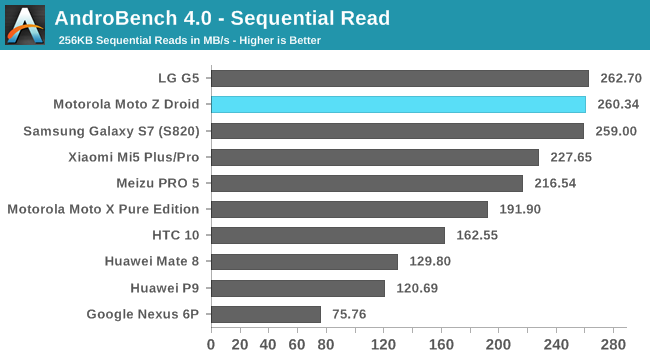
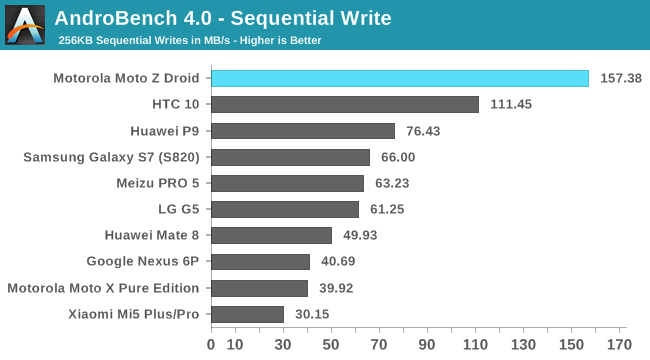

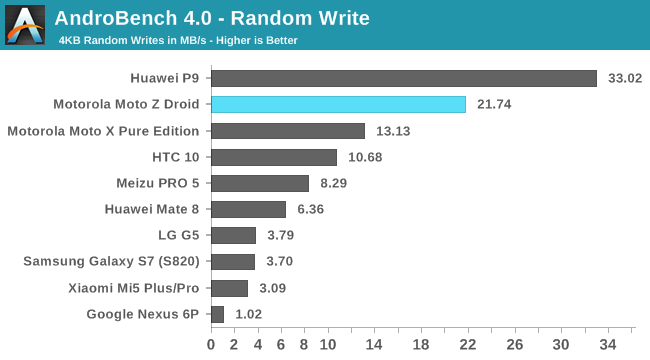
One of the first things I noticed about the new Moto Zs is how quickly they can install and launch apps. Their sequential write performance is excellent, nearly as fast as the iPhone 6s, and sequential read performance is among the best we’ve measured. Random read and write performance is also very good, meeting or exceeding the performance of most flagship phones.
The Moto Z Droid and Moto Z Force Droid we tested are both using 32GB of Samsung KLUBG4G1CE-B0B1 UFS 2.0 NAND. This is the same NAND used by the Galaxy S7 (Snapdragon 820) we tested, so this alone cannot account for the difference in performance. It seems Motorola has done some software tuning to improve internal storage speed.
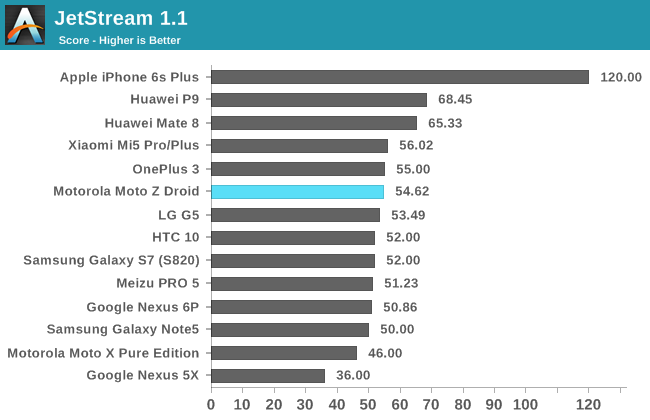
Similar to PCMark’s Web Browsing test, there’s a clear hierarchy in JetStream based on CPU architecture and frequency. The higher-clocked Cortex-A72 cores in Huawei’s P9 and Mate 8 give them a 25% and 20% advantage over the Moto Z Droids, respectively. All of the phones with Qualcomm’s Kryo cores clump together as expected, followed by the phones using the previous generation A57 cores.
GPU Performance
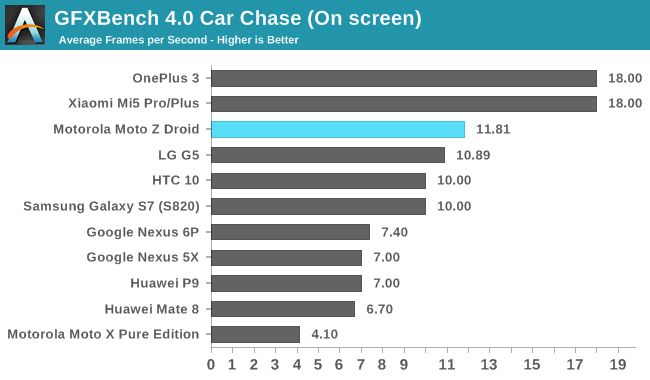
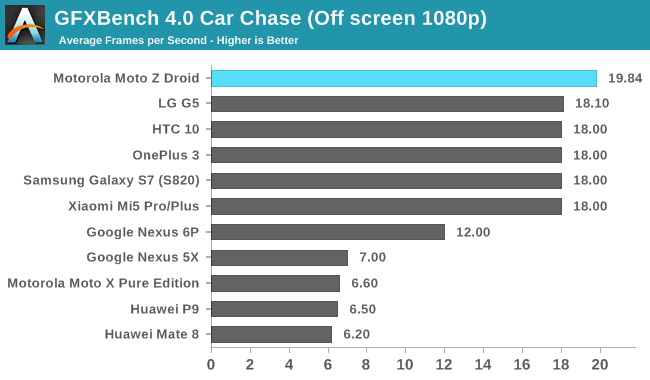
The Adreno 530 GPU in Qualcomm’s Snapdragon 820 performs well in GFXBench Car Chase, a game simulation that uses OpenGL ES 3.1 plus Android Extension Pack (AEP) features, including hardware tessellation. All of the phones with this GPU inside hit 18fps in the offscreen test except the Moto Z Droids, which see a 10% boost from their updated GPU driver. The OnePlus 3 and Xiaomi Mi5 pull ahead in the onscreen test because of their lower-resolution 1080p displays, but the Moto Z Droids still outperform the other QHD resolution phones.
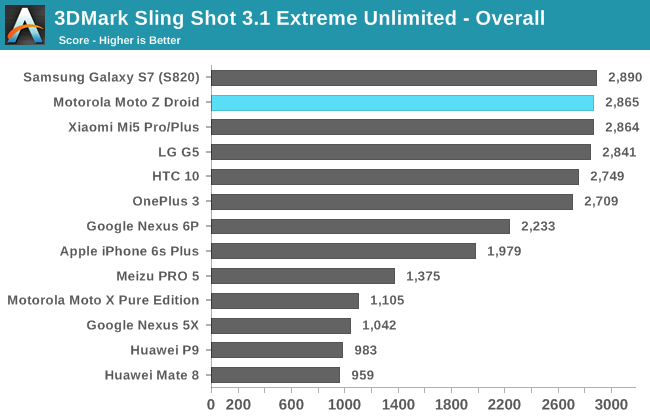
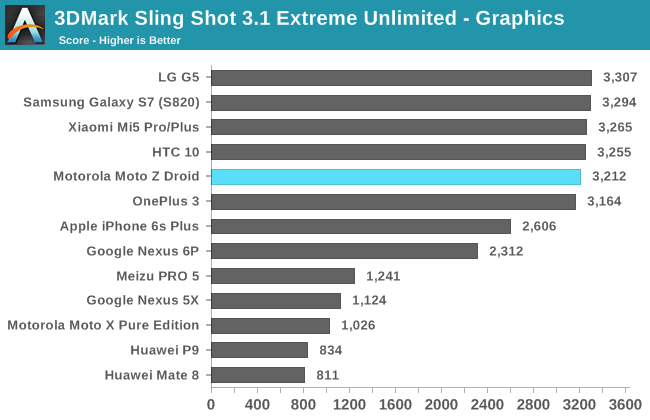
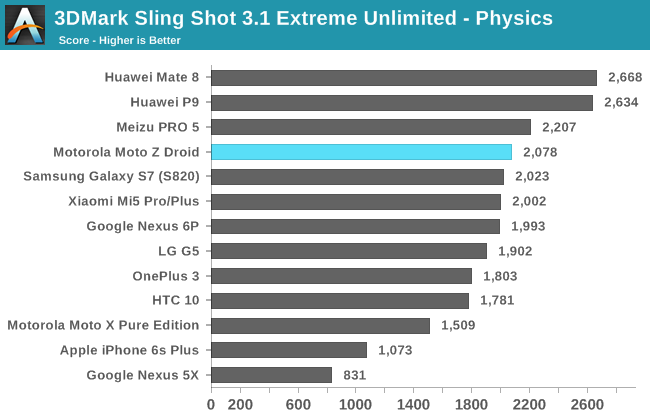
3DMark Sling Shot Extreme is another OpenGL ES 3.1 game simulation that renders offscreen at a higher 1440p resolution than our other tests and does not use hardware tessellation. Once again we see the phones using the Adreno 530 GPU perform well in the Graphics test. Interestingly, the Moto Z Droids see no uplift in performance here from their newer driver.
The Physics test renders offscreen at 720p and primarily tests CPU and memory controller performance. ARM’s A57/A72 CPUs and memory controller handle this particular workload better than Qualcomm’s solutions. The Moto Z Droids are the fastest Snapdragon 820 phones, though.
Both Moto Z Droids deliver excellent performance. Even though they share much of the same internal hardware with other current flagship phones, an updated GPU driver and other software tweaks give them a slight edge in most workloads. Internal storage performance is excellent, leading to quick app loads and installs. Poking around in the UI and scrolling in web pages seems just a little faster when compared to the Galaxy S7 edge, too.
Battery Life
Our battery life tests simulate a few common workloads while controlling as many variables as possible, including calibrating each display to 200 nits at 100% APL.
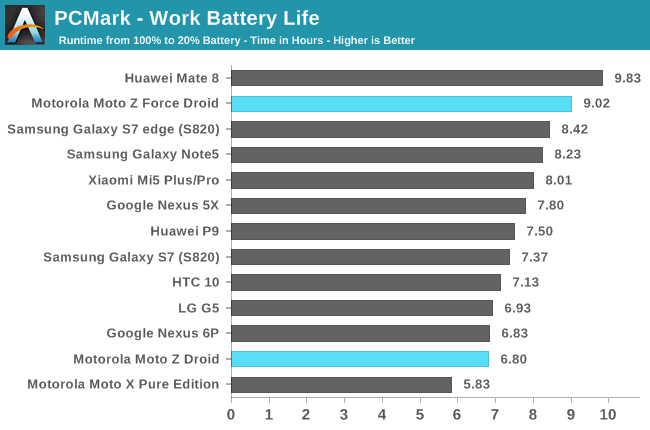

One of the primary differences between the Moto Z Droid and Moto Z Force Droid is battery size. At 2600mAh, the thinner Droid’s battery is undersized for a phone with a 5.5-inch display. The Moto Z Force Droid’s 3500mAh battery helps it last 33% (or just over 2 hours) longer in PCMark’s battery test, while the Galaxy S7 edge lasts 24% (or 1 hour and 37 minutes) longer. Even phones with smaller screens, such as the Huawei P9, HTC 10, and Galaxy S7, have larger batteries (3000mAh) than the Moto Z Droid, giving them marginally better battery life in this test. The LG G5’s battery is not much larger than the Moto Z Droid’s, so it’s no surprise they finish so close together. The Moto Z Force Droid manages to last 9 hours, longer than the other flagship phones we’ve tested except the Mate 8 and its 4000mAh battery.
After normalizing for battery size, both Moto Zs consistently last 7-10% longer in this test than other Snapdragon 820 phones. Without more specific testing it’s impossible to say if this small difference is the result of their higher-performing GPU driver allowing the Droids’ Adreno 530 to finish its work and get back to sleep more quickly, software settings, SoC binning, or something else.
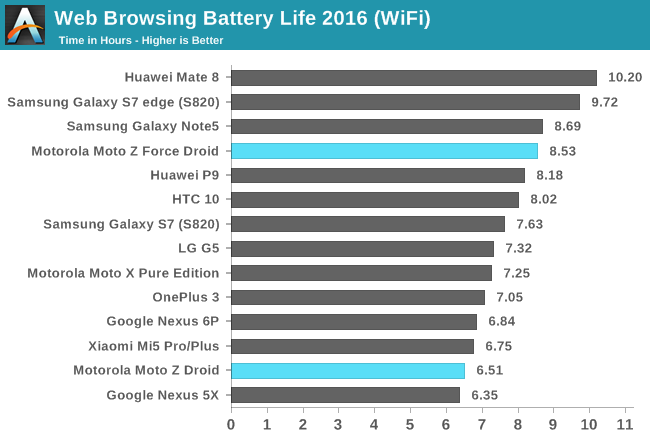
Our new browsing test makes better use of the CPU by pausing and then scrolling through each page after it’s loaded, but display power draw is still the limiting factor, with some additional power used by the wireless radio. In this scenario, the Moto Z Droids no longer show any significant advantage over their peers after normalizing for battery size. The Galaxy S7 edge’s average platform power is 11% less than the Moto Z Force Droid and the HTC 10 is 7% less than the Moto Z Droid, but the differences between the other Snapdragon 820 devices is no more than 5%. In general, battery life in this test closely follows the ratio of screen size to battery size, which puts the Moto Z Droid’s combination of a large screen and small battery at a disadvantage.
Attaching the 2220mAh Power Pack to the back of the Moto Z Force Droid extends battery life by 4.43 hours, or 52%, for a total runtime of 12.96 hours. The Power Pack adds about the same time to the thinner Moto Z, or 65%, for a total runtime of 10.72 hours. These tests were run using the “Efficiency Mode” setting that’s supposed to increase battery life by up to 20% by only charging the phone once it drops below 80% instead of keeping it topped off.
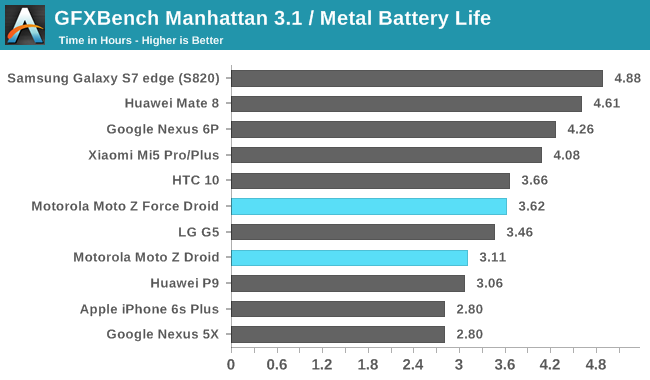
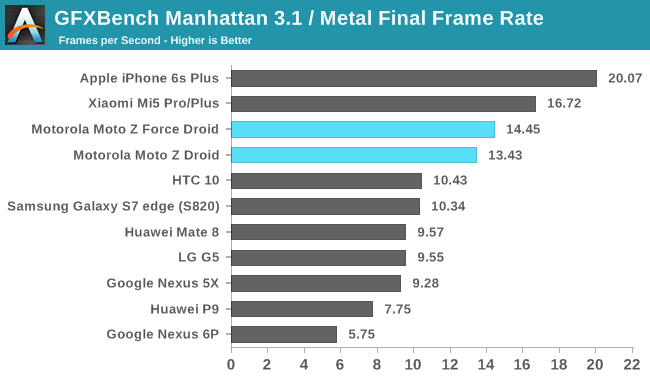
The larger battery in the Moto Z Force Droid is only good for an extra half hour of gaming in the GFXBench Manhattan 3.1 battery life test. Both Droids last more than 3 hours when pushing their GPUs hard, but they fall behind the Galaxy S7 edge and even the Nexus 6P and LG G5 in runtime; however, the Droids maintain a higher level of performance throughout the test, effectively doing more work than the other devices, which leads to the reduction in battery life. Because this test renders at the device’s native resolution, the 1080p displays in the iPhone 6s Plus and Xiaomi Mi5 Pro help them last longer and perform better than the Droids and other phones with QHD displays.
Flagship phones have enough peak performance to handle any game currently available, but they generate a lot of heat and are susceptible to thermal throttling—the process of reducing GPU frequency and performance to stay within an acceptable thermal envelope. While running GFXBench Manhattan ES 3.1, the HTC 10’s frame rate drops 35% because of throttling, eliminating its performance advantage over midrange GPUs that have better thermal stability. The Galaxy S7 edge (Snapdragon 820) also experiences a significant 33% drop in performance starting at the 8 minute mark. After dropping to a minimum of less than 8fps, performance stabilizes into a steady-state pattern after 31 minutes.
The Moto Z Droid has less thermal mass because it’s so thin, which means it should heat up more quickly than thicker phones. The graph above shows this is indeed the case, as the Moto Z Droid starts reducing GPU frequency after only 7 minutes. It reaches thermal equilibrium after 18 minutes and enters a period where it must constantly adjust frequency to stay within comfortable operating limits. Its overall performance drop of 28% is a little bit less than other Snapdragon 820 phones we’ve tested, however.
The thicker and heavier Moto Z Force Droid maintains peak performance for 12 minutes before gradually reducing GPU frequency. It takes 37 minutes to reach thermal equilibrium, with frame rates only 21% lower than peak values.
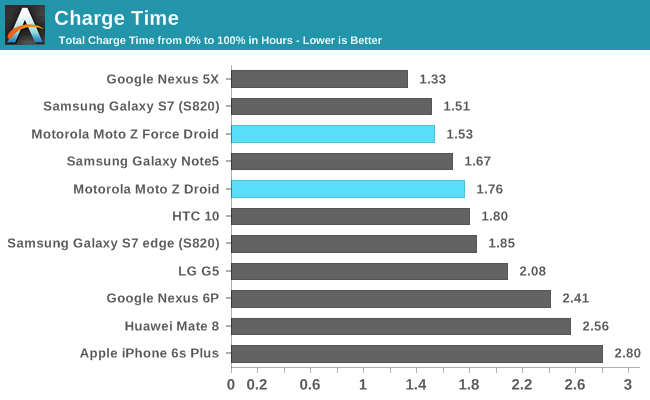
Both of the Moto Z Droids support Motorola’s TurboPower rapid charging technology. The small power bricks the phones ship with take up two slots on a standard power strip and have permanently attached cords rather than a separate cord that attaches via USB.
The Moto Z Force Droid’s charger is rated for 28.5W, which translates to a peak of 33W at the wall and 24.9W at the battery. Its peak charge cycle lasts 11 minutes and charges the battery 30% before gradually stepping down input power. The battery reaches 50% charge in 19 minutes and is fully charged in just 1.53 hours, a little faster than the Galaxy S7 edge and Galaxy Note5.
The Moto Z Droid uses a smaller 15W charger that delivers a peak of 11.1W at the battery. Its peak charge cycle lasts 43 minutes before it reduces input power. Its charge rate is slower than the Galaxy S7, especially when factoring in its larger 3000mAh battery, but its charge level still reaches 50% in 30 minutes and is fully charged in 1.76 hours.
Unlike some phones that reduce their charging rate when the display is turned on, both Moto Z Droids charge at peak levels whether the screen is on or off so long as the battery remains below its thermal threshold.
Final Words
Over the past few years, Motorola’s phones have stuck to the same formula—unique design, conservative features, near-stock Android, and reasonable pricing. Rather than tweak a few variables and release updated Moto X models, however, Motorola derived a completely new formula with an output variable equal to Z.
Motorola is the latest company to embrace the modular smartphone concept, following LG’s G5 earlier this year and Google’s continued efforts with project Ara. The premise is simple: extend the phone’s capabilities by attaching modules with additional sensors, speakers, controls, etc. instead of cramming everything into the phone itself and making it too cumbersome and expensive. We’ve yet to see any compelling modules amongst LG’s Friends and Motorola’s Moto Mods, though—a problem, I think, that extends beyond lack of imagination or engineering talent. A smartphone’s strengths are its high level of integration and wireless radios for communicating with external devices. Sticking a separate module to the phone negates both its wireless capability and its tightly integrated hardware, creating something that’s neither as good as a phone with that feature integrated inside nor a phone coupled with a wireless accessory.
While I’m still not sold on the modular concept, Motorola’s Moto Mod system is the most compelling. Its use of strong magnets makes attaching and removing the modules a snap. Best of all, they’re hot swappable. Unlike LG’s system, there’s no need to reboot the phone; the module just snaps on and works as expected with tight integration with the operating system.
As I alluded to above, you cannot get something for nothing: Some design compromises were necessary to make this modular system work. Because the modules add bulk to the phone, Motorola worked to minimize the Moto Z’s own weight and thickness. The Moto Zs’ thin profiles and flat backs result in a significant camera hump, no 3.5mm headphone jack, and, for the thinner Moto Z at least, limited battery capacity. Despite Motorola’s efforts to make the back of the phone visually appealing, the camera hump, exposed electrical contacts, and less-than-comfortable feel from the flat back and unblended sides make the phones feel incomplete without a Moto Mod or Style Shell attached.
The Moto Z Droid’s undersized 2600mAh battery places it behind nearly every other flagship phone in our battery tests. Despite their smaller size, the Huawei P9, HTC 10, and Galaxy S7 all have larger 3000mAh batteries and longer runtimes. Heavy users who cannot top off the phone while on the go will likely need to use the modular battery pack to make it through a full day. This does boost capacity to 4820mAh, but it’s still thicker and heavier than the Moto Z Force Droid, whose 3500mAh battery can last a whole day on its own.
Besides the design shortcomings, there is not much else to complain about. The Moto Z Droids are excellent performers and among the fastest phones currently available. Internal NAND performance is particularly strong, which translates to faster app launches and installs. An updated driver makes the Adreno 530 GPU’s peak performance even better, and both Moto Z Droids experience less thermal throttling than other Snapdragon 820-based phones such as the HTC 10 and Galaxy S7 edge.
The Moto Z Force Droid’s camera also performs well. It’s among the best, if not the best, camera currently available when shooting in good light. Low-light performance is also very good, but the Galaxy S7 is just a little better. The Moto Z Droid handles exposure and white balance nearly as well, but its lower-resolution sensor captures less detail and it suffers from purple fringing along the edges of dark objects on light backgrounds. Its lens also shows a loss of sharpness in the corners.
Motorola offers two settings for the Moto Z Droids’ 5.5-inch QHD displays: one that takes advantage of AMOLED’s larger gamut to display more vibrant colors and another calibrated for sRGB that prioritizes color accuracy. The only negative issue, which affects both modes, is a blue-shifted white point that degrades grayscale accuracy. Peak brightness is similar to other AMOLED panels at about 350 nits at 100% APL. Like Samsung’s phones, the Moto Zs’ auto-brightness mode boosts peak brightness to 504 nits for improved viewing in sunlight.
Motorola continues to ship a nearly stock version of Android 6.0.1 Marshmallow that relies almost entirely on Google’s apps. The only exceptions are Motorola’s redesigned camera app, which now includes onscreen controls for the shutter, HDR, flash, and timer, along with a professional mode for controlling focus, white balance, shutter speed, and ISO manually, and its “Moto” app (shown below), which continues to be the gateway to Motorola’s extra features.
There’s a “Quick Capture” action that opens the camera from the lock screen or from within any app by twisting your wrist twice. You can also swipe up from the lower bezel to shrink the screen, which is a new one-handed feature for the Moto Z. One of the features I’ve always liked about Motorola’s phones is the ability to wave my hand over the phone to trigger Moto Display. This is great for checking the time and notifications when the phone is sitting on a desk. Moto Voice is Motorola’s version of Apple’s Siri, allowing you to issue voice commands after speaking a customizable launch phrase. It can also read incoming calls and messages out loud when it notices you’re in a specific environment, like your car.
Because the Moto Z Droid Editions are Verizon exclusive phones, they come with the usual carrier blight and bloatware. By my count there are 7 Verizon apps, including “Message+” that replaces the default messaging app, and 10 others you probably do not want, some of which cannot be removed.
Back when Google still owned Motorola, the company was known for its relatively timely software updates; however, under new parent company Lenovo, its updates have been rolling out far more slowly. Using last year’s Moto X and Moto G as examples, Motorola now appears to be on a quarterly release schedule for security updates. We asked Motorola about software support, and while it remains committed to providing software and security updates for its products, it will not provide them on a monthly basis. Instead, multiple monthly security updates will either be bundled together or rolled out with even less frequent OS updates, leaving its customers exposed to critical vulnerabilities for several months. I understand the economics behind this decision even if I do not approve: Software maintenance, testing, and validation costs real money. But the Moto Zs are not inexpensive $100 phones with a razor thin profit margin—these are phones selling for more than $600. If Motorola is going to charge a premium for its phones, then it needs to deliver a premium experience, which includes monthly security updates.
Motorola’s Moto Mod system works well, but the modular smartphone theory remains unproven. A modular system will always be thicker, heavier, and more costly than a tightly integrated one, and we have yet to see any truly enticing, must-have modules that justify these tradeoffs. Motorola seems committed to the idea, though, so perhaps some interesting use cases will evolve.
If you find the current Moto Mods appealing, the Moto Z Droid is the best option. Its thinner and lighter frame means less bulk with a module attached, and its smaller battery can be supplemented by a Power Pack or one of the other Moto Mods’ internal batteries. If you’re not interested in the modules, then the Moto Z Force Droid, with its bigger battery, better camera, and Moto ShatterShield screen, is the better choice and a great performing phone as long as you cover the naked back with a Style Shell and can live with Motorola’s software update policy. However, at more than $600 and $700, respectively, the Moto Z Droid and Moto Z Force Droid do not deliver the same value as previous offerings. It’s hard to justify these prices when you can get a comparable high-end phone for less money and pair it with a cheaper wireless or wired accessory to get the same functionality.


